The Philippines is known for its diverse flora and fauna, and one of the country’s treasures is its avian population. With over 600 bird species found in various habitats in the country, the Philippines is considered one of the world’s biodiversity hotspots for birds.
Philippine birds range from the smallest, such as the Philippine Pygmy Woodpecker, to the largest, like the Philippine Eagle, known for its impressive size and strength.
These birds play a vital role in the country’s ecology, including pollination, seed dispersal, insect and rodent control, and ecosystem balance.
Furthermore, many of these bird species are endemic, meaning they can only be found in the Philippines, making them a unique and fascinating part of the natural world.
In this article, we will explore some of the most notable bird species found in the Philippines and their importance in the country’s biodiversity.
1. Chinese Sparrowhawk
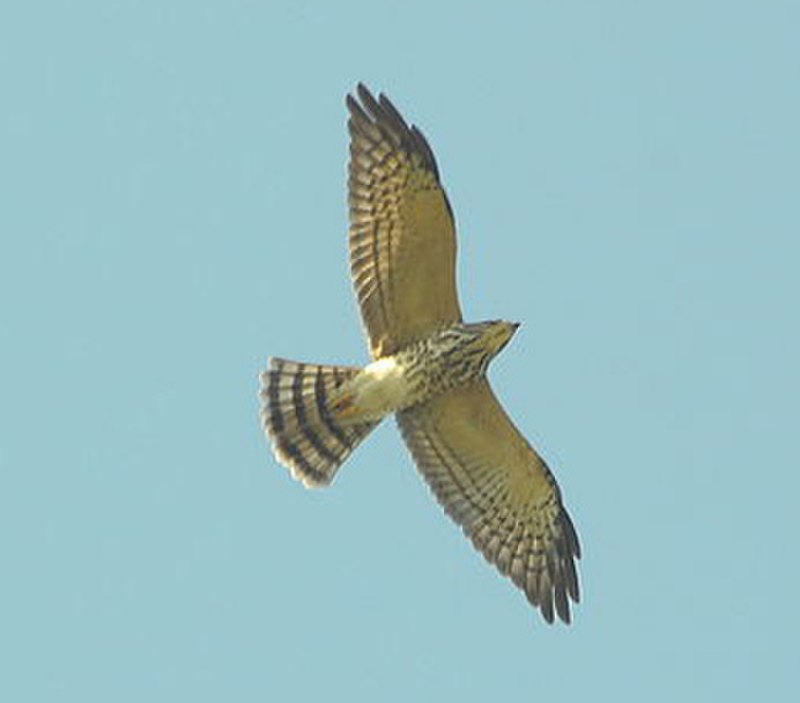
The Chinese sparrowhawk is a bird of prey in the family Accipitridae. It breeds mainly in Southeast China, Taiwan, Korea, and Siberia and migrates to Indonesia and the Philippines during winter.
The average length of this species ranges from 30-36 cm with females being larger than males. They have prominent black wing tips which help them identify easily among other birds.
Their diet consists mostly of small mammals like mice or lizards as well as insects such as grasshoppers or locusts that live near forests where they nest.
This species faces threats due to habitat loss for agricultural use so conservation efforts are necessary for their survival.Scientific classification:
| Kingdom | Animalia |
| Phylum | Chordata |
| Class | Aves |
| Order | Accipitriformes |
| Family | Accipitridae |
| Genus | Accipiter |
| Species | A. soloensis |
Also Featured In: Most Common Birds in China, Birds that Commonly Found in Bali
2. Chinese Egret
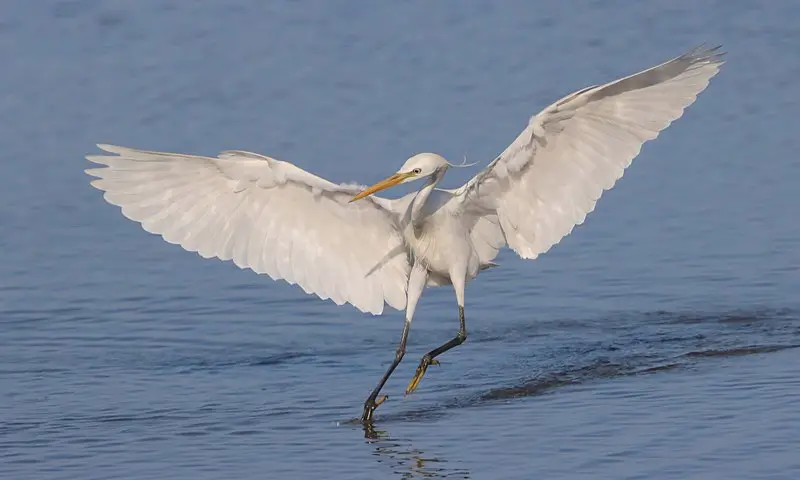
The Chinese egret is a unique species of egret found in east Asia. It was first discovered by Robert Swinhoe in 1860 and stands about 68 cm tall with an all-white plumage resembling the little egret.
During the non-breeding season, its bill has a dusky hue at the base with a tannish peach above it. These graceful birds are now classified as ‘Threatened’ due to habitat.
Destruction and hunting for their feathers which were used extensively during fashion trends of previous centuries.
Conservation efforts such as protected reserves have been implemented to help safeguard these beautiful creatures from further declineScientific classification:
| Kingdom | Animalia |
| Phylum | Chordata |
| Class | Aves |
| Order | Pelecaniformes |
| Family | Ardeidae |
| Genus | Egretta |
| Species | E. eulophotes |
3. Besra
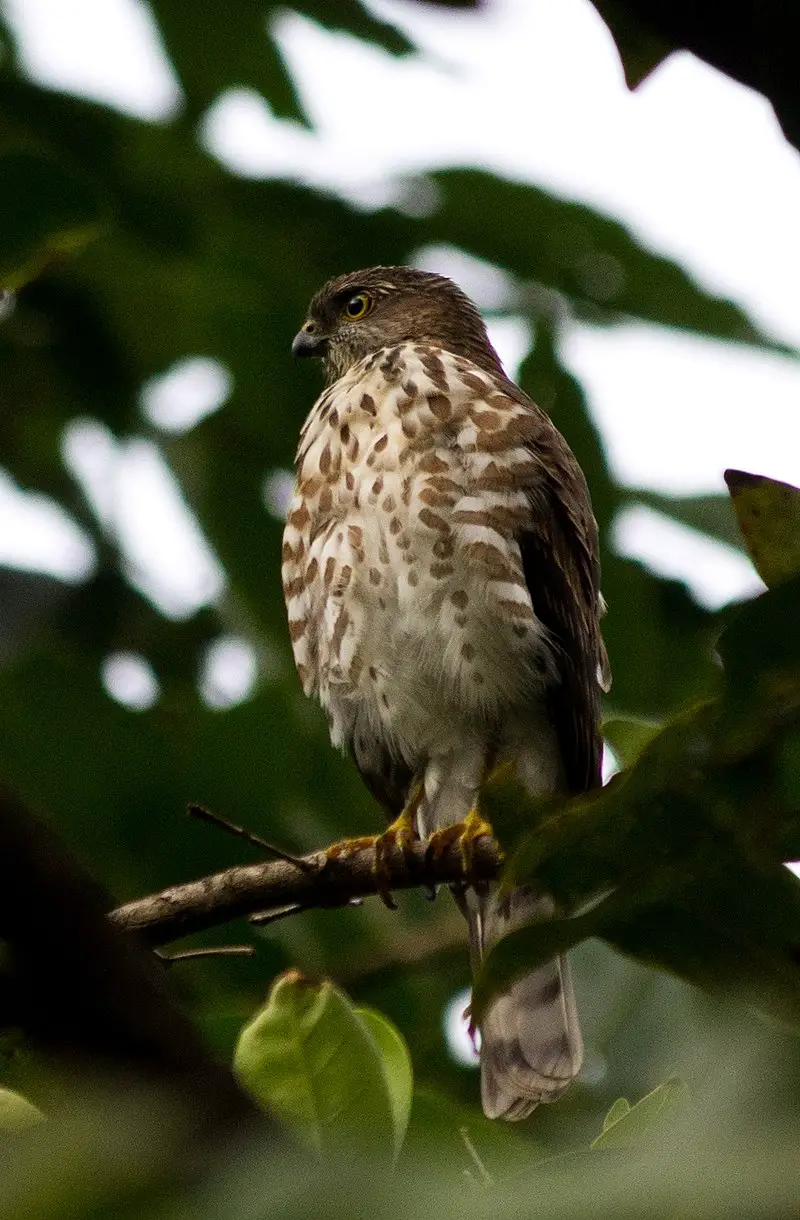
The Besra is a small bird of prey, belonging to the Accipitridae family. It can be found in dense forests across Southern Asia and East Asia.
The besra typically builds new nests each year, usually out of twigs and leaves, laying 2-5 eggs at a time.
Its size ranges from 29 t 40cm long with broad wings for soaring through the air quickly and efficiently when hunting for its food which mainly consists of insects or other small animals like rodents or lizards.
This agile predator uses its sharp vision to locate potential meals both on land as well as water bodies nearby where it may swoop down to catch unsuspecting fish too.Scientific classification:
| Kingdom | Animalia |
| Phylum | Chordata |
| Class | Aves |
| Order | Accipitriformes |
| Family | Accipitridae |
| Genus | Accipiter |
| Species | A. virgatus |
Also Featured In: Beautiful Indonesian Birds, Birds of Karnataka
4. Accipitridae
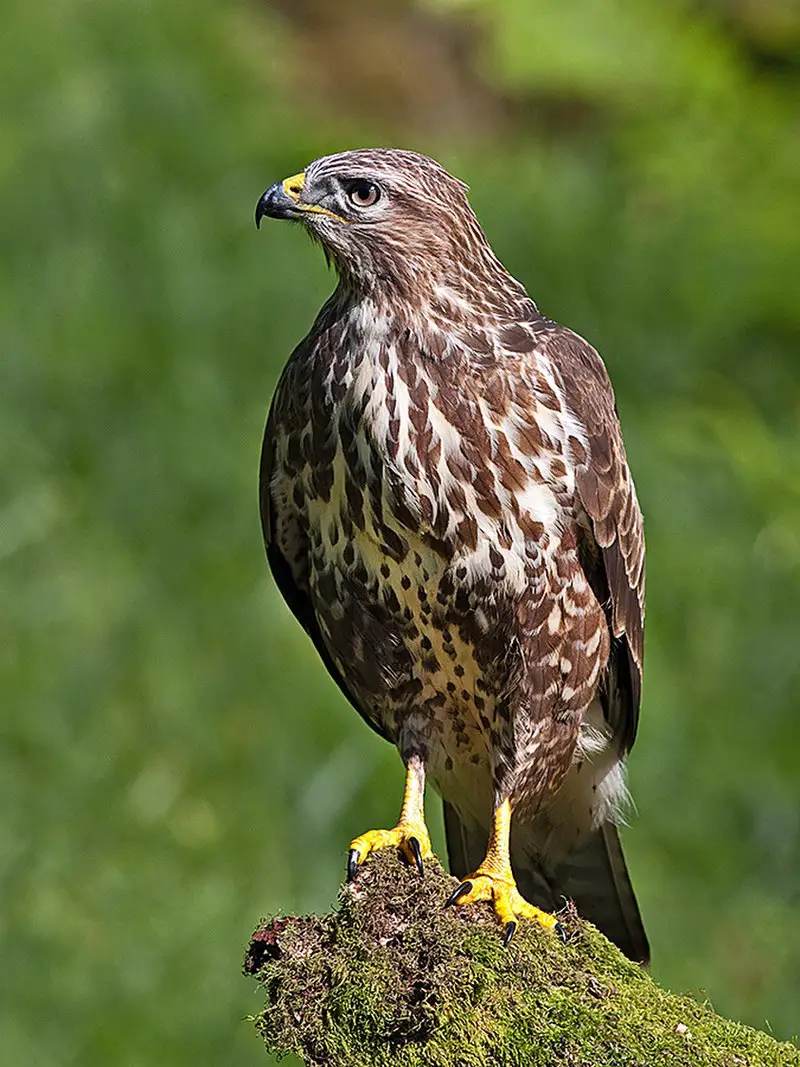
Accipitridae birds are a diverse family of raptors ranging in size from small to large. They have powerful hooked beaks which they use for hunting and tearing apart their prey, such as insects, medium-sized mammals and carrion.
Some species even feed on fruit. These birds can be found all over the world, making them an incredibly successful group of predators.
Accipitridae are adaptable hunters with keen eyesight that helps them spot potential meals from far away distances.
Their sharp talons assist them in grasping onto their victims while feeding or defending themselves against enemies.
Not only do these avian creatures provide us with visual beauty but also help keep our ecosystems healthy by keeping pest populations under control.Scientific classification:
| Kingdom | Animalia |
| Phylum | Chordata |
| Class | Aves |
| Order | Accipitriformes |
| Family | Accipitridae Vieillot, 1816 |
Also Featured In: Most Common Types of Bangladeshi Birds, Italian Birds You Should Know
5. Palawan Peacock-Pheasant
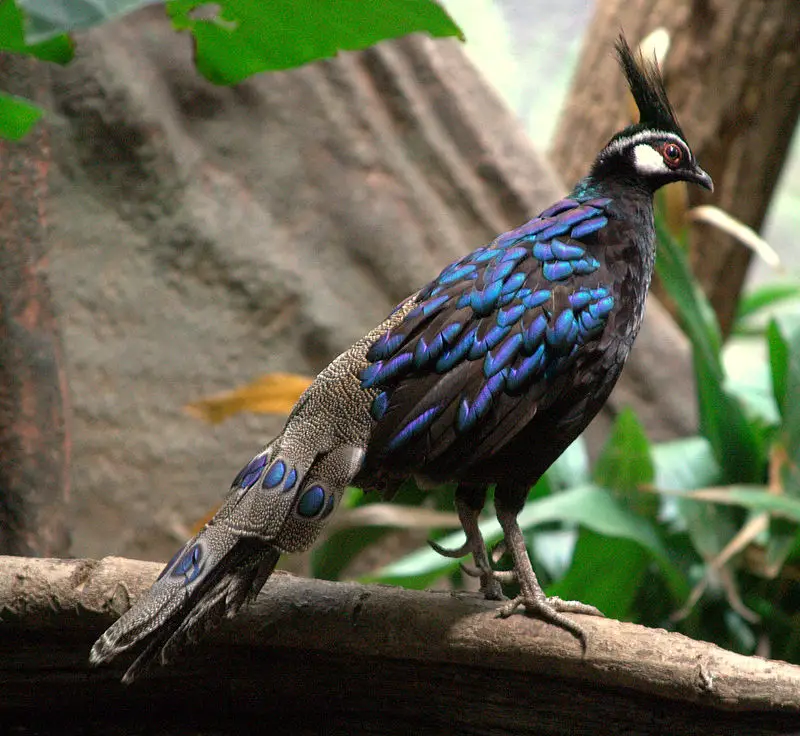
The Palawan peacock-pheasant is a stunningly beautiful bird, native to the Philippine island of Palawan. It has an erectile crest and iridescent feathers in shades of blue, green and purple that fan out into a magnificent tail when it spreads its wings.
This majestic creature stands up to 50 cm tall and can be found inhabiting dense forests with plenty of undergrowth for shelter.
Its presence is deeply rooted in the culture of indigenous people living on this tropical paradise – so much so that it even features prominently on the seal used by Puerto Princesa City.
Moreover, due to its beauty, charm and rarity – being listed as vulnerable by IUCN red list assessment– tourists come from around the world simply hoping for a glimpse at this remarkable species in their natural habitat.Scientific classification:
| Kingdom | Animalia |
| Phylum | Chordata |
| Class | Aves |
| Order | Galliformes |
| Family | Phasianidae |
| Genus | Polyplectron |
| Species | P. napoleonis |
Also Featured In: Birds of the Philippines, Palawan Island Birds
6. Rufous Hornbill
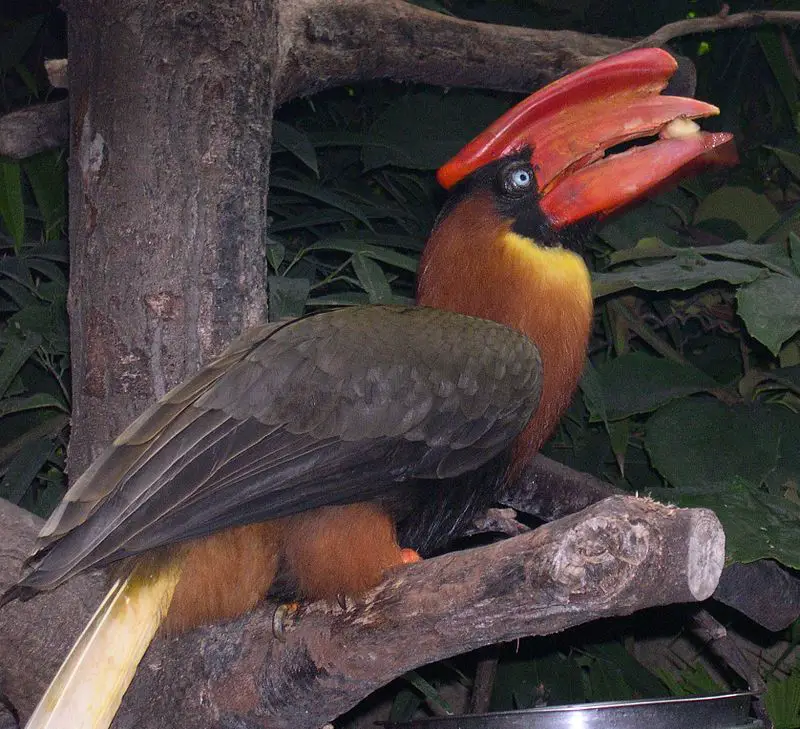
The Rufous hornbill is a large and majestic bird endemic to the Philippines. Residing in moist tropical lowland forests, locals affectionately refer to them as “the clock of the mountains” due to their booming calls that echo through canyons every hour – an unmistakable sound in these parts.
The males are adorned with a bright red bill and casque while females have entirely black bills.
These birds make for excellent companions, being highly social animals known for forming strong bonds with each other.
So why not take some time out of your day and admire this incredible species?Scientific classification:
| Kingdom | Animalia |
| Phylum | Chordata |
| Class | Aves |
| Order | Bucerotiformes |
| Family | Bucerotidae |
| Genus | Buceros |
| Species | B. hydrocorax |
Also Featured In: Siargao Island Birds You Didn’t Know,
7. Red-Vented Cockatoo
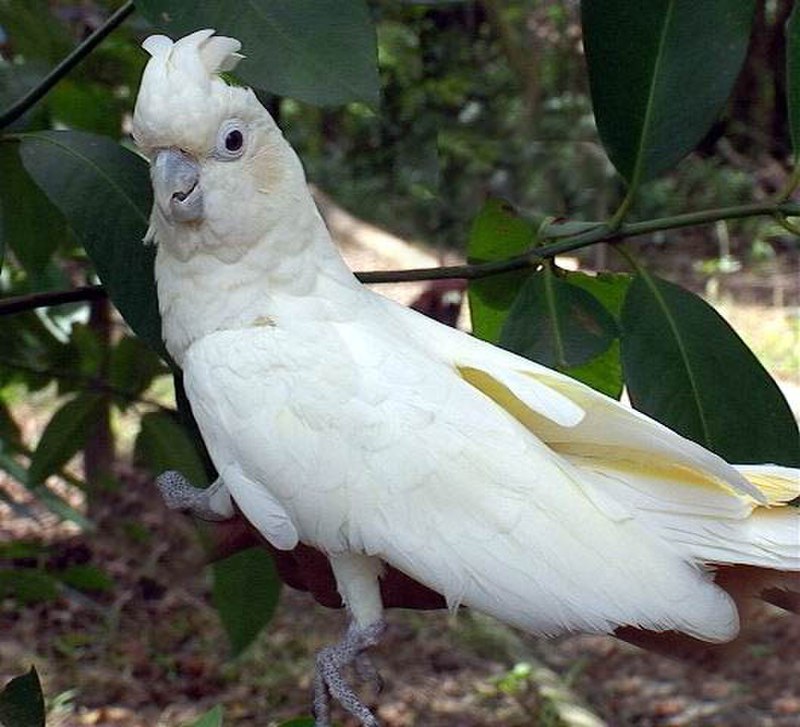
The red-vented cockatoo is a species of parrot found in the Philippines. It has an iconic crest, white feathers and a bright red underbelly.
These birds are roughly the size and shape of typical cockatoos and can grow up to 20 inches long with a wingspan between 26 and 31 inches wide.
While their natural habitat is threatened by environmental degradation, illegal pet trades, as well as hunting for food or sport, there have been some efforts from organizations like Katala to protect these animals.
The Philippine Cockatoo’s diet consists mostly of fruits, nuts seeds and other vegetation but they will also feed on insects when necessary.
They live in large groups that occupy specific territories within their range while constantly searching for new sources of food throughout the year – making them highly adaptable creatures.Scientific classification:
| Kingdom | Animalia |
| Phylum | Chordata |
| Class | Aves |
| Order | Psittaciformes |
| Family | Cacatuidae |
| Genus | Cacatua |
| Subgenus | Licmetis |
| Species | C. haematuropygia |
8. Philippine Falconet
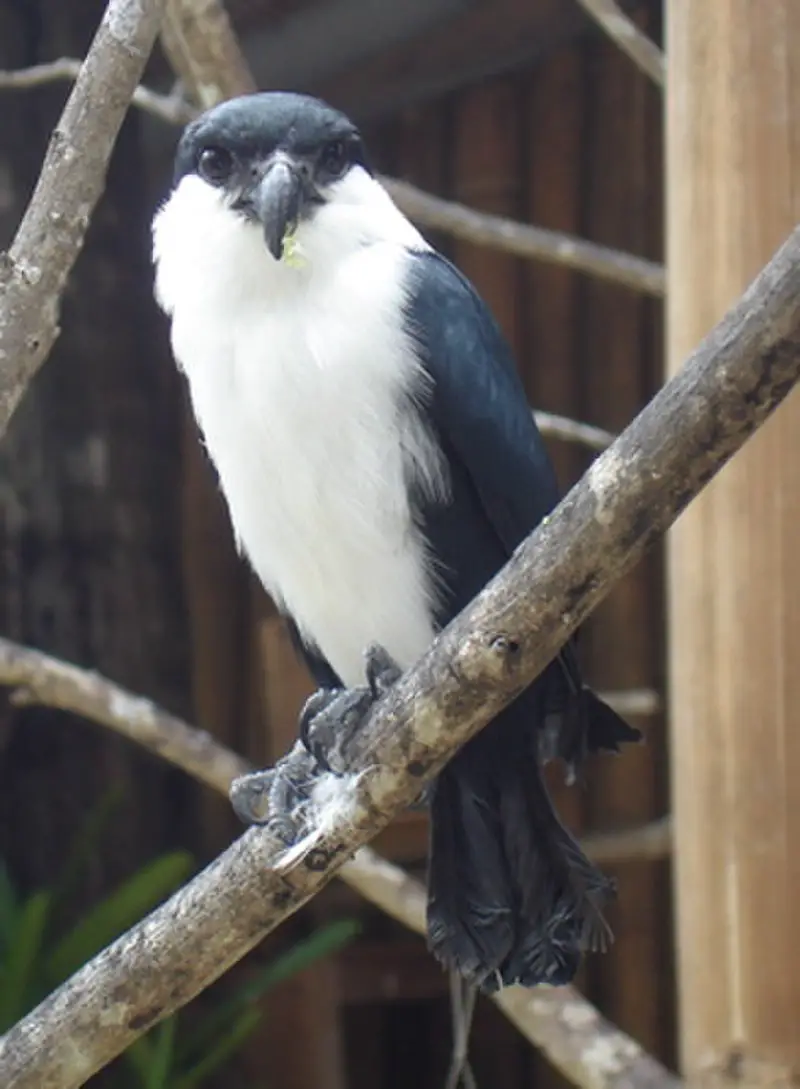
The Philippine falconet is a species of bird of prey that is endemic to the lowland forests in Philippines.
They can be seen near open forest edges hunting flying insects and nesting in woodpecker holes of dead trees.
It’s fairly common within their suitable habitats, though it has become threatened due to deforestation and illegal trapping for pet trade.
Its diet consists mainly of insects such as beetles, moths and grasshoppers which they catch mid-flight with its powerful talons while soaring up high.
Conservation efforts have been put into place to preserve this beautiful creature from extinction by protecting its habitat and monitoring the illegal trading activities so that future generations can witness them in their natural environment.Scientific classification:
| Kingdom | Animalia |
| Phylum | Chordata |
| Class | Aves |
| Order | Falconiformes |
| Family | Falconidae |
| Genus | Microhierax |
| Species | M. erythrogenys |
9. Scale-Feathered Malkoha
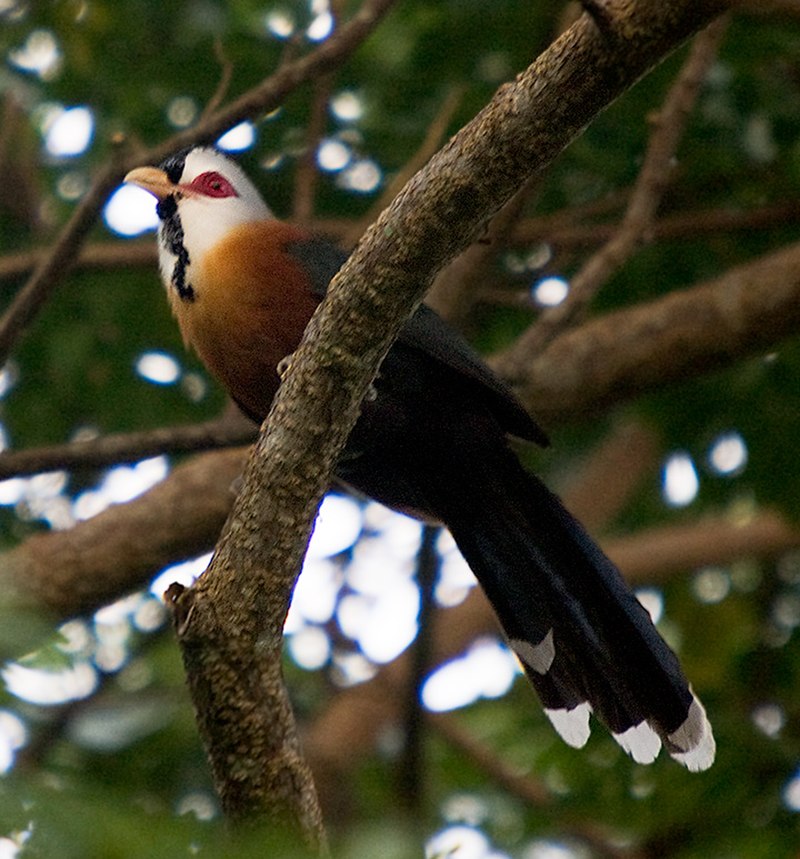
The Scale-feathered malkoha is a large species of cuckoo found only in the northern Philippines.
Both sexes have unique plastic-like feathers on their head and throat, with grey or almost white colouring on the throat that extends to upper breast, where black scale-like tips are visible.
The upper back forms a continuous line from head to wings. These stunning birds can be seen flying through forests or perching atop branches singing sweet melodies.
They feed mainly on insects and fruits but will take advantage of any available food sources they come across.
With their beautiful colours and melodious songs, these mesmerizing creatures make wonderful additions to any nature lover’s backyard garden.Scientific classification:
| Kingdom | Animalia |
| Phylum | Chordata |
| Class | Aves |
| Order | Cuculiformes |
| Family | Cuculidae |
| Genus | Dasylophus |
| Species | D. cumingi |
10. Philippine Duck
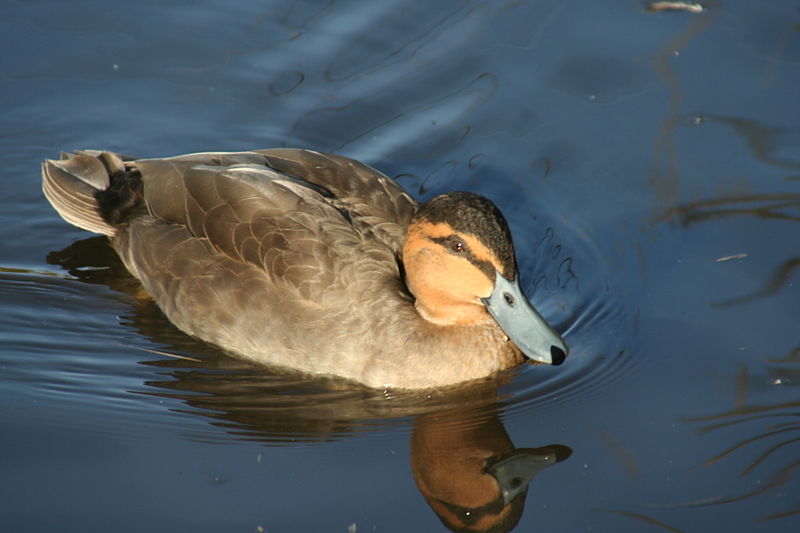
The Philippine Duck is an endemic species to the Philippines and belongs to the genus Anas. It is a large dabbling duck, characterized by its dark brown plumage with white patches on their wings.
Its native name is papan and it feeds mostly on shrimp, fish, insects and vegetation found in wetland areas across the country.
The Pacific clade of Anas also includes this bird as there are no subspecies for them so they remain monotypic birds.
They inhabit all types of wetlands including ponds, lakes rivers or even mangroves making them versatile waterfowls that can adapt easily to different environments without much difficulty.
Conservation efforts have been implemented since 1995 ensuring their safety from any threats like hunting and illegal trade which might lead towards extinction if not addressed right away.Scientific classification:
| Kingdom | Animalia |
| Phylum | Chordata |
| Class | Aves |
| Order | Anseriformes |
| Family | Anatidae |
| Genus | Anas |
| Species | A. luzonica |
11. Philippine Serpent Eagle
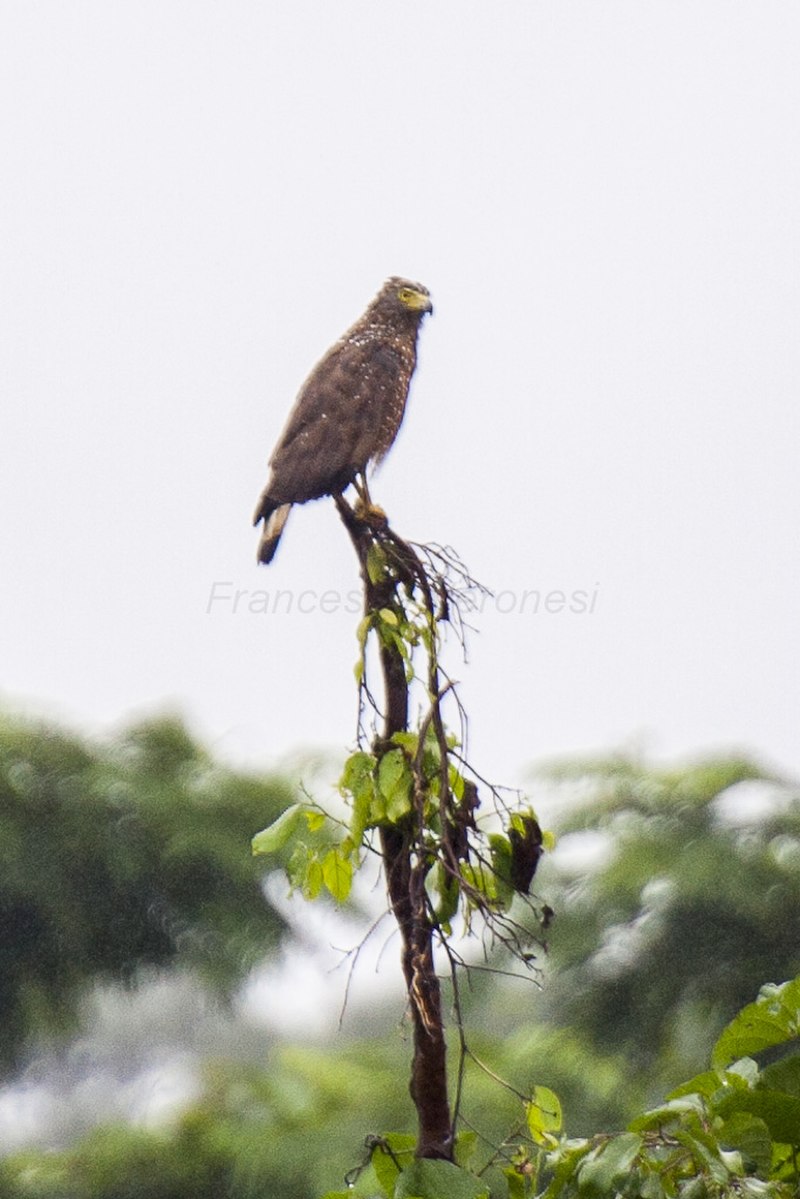
The Philippine serpent eagle is an impressive bird of prey, endemic to the major islands in the Philippines. It has a chestnut brown back and wings with white undersides that are streaked black.
Its distinct long crest gives it its name—serpent eagle. This species can be found in forest clearings, open woodlands or even cultivated lands with scattered trees.
They feed on small mammals like lizards and rodents as well as birds and reptiles they catch while soaring over their habitat searching for food.
The population of this majestic raptor is threatened by deforestation due to human activities such as logging which continue to reduce its natural habitats making them more vulnerable to extinction if conservation measures aren’t taken soon enough.Scientific classification:
| Kingdom | Animalia |
| Phylum | Chordata |
| Class | Aves |
| Order | Accipitriformes |
| Family | Accipitridae |
| Genus | Spilornis |
| Species | S. holospilus |
12. Olive-Backed Sunbird
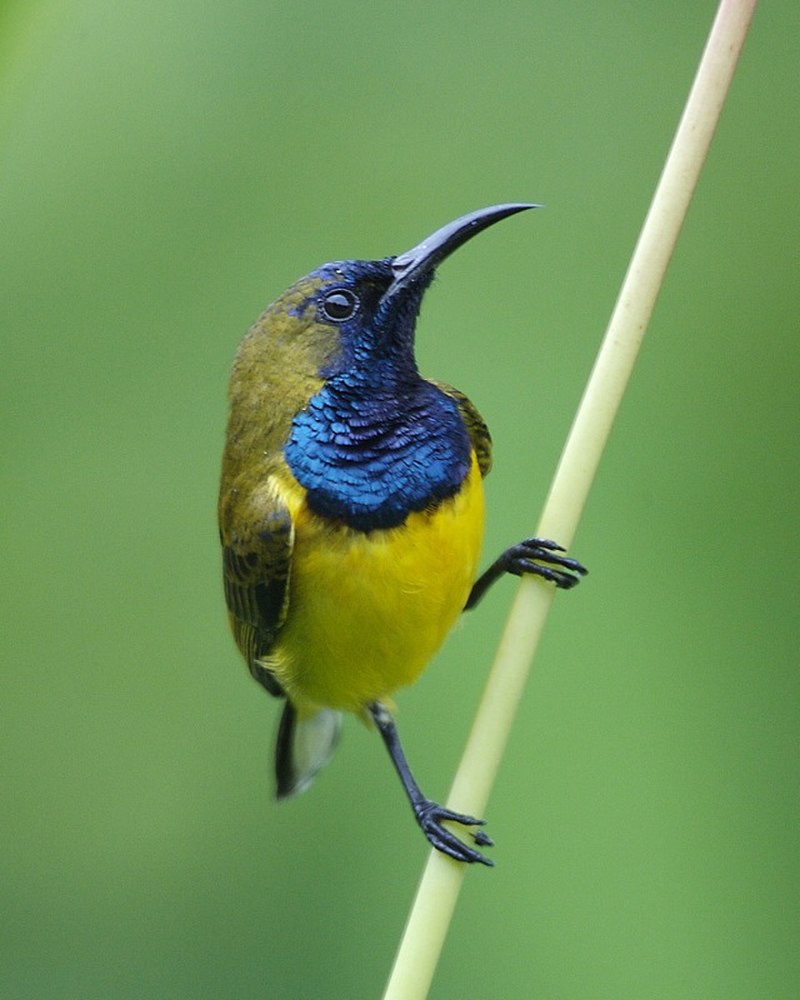
The Olive-backed Sunbird is a vibrant species of sunbird found in Southern Asia and Australia. Its striking yellow underbelly complements its olive upperparts, making it an attractive sight to behold.
First described by Mathurin Jacques Brisson in 1760 based on a specimen from the Philippines, this small songbird loves nectar but will also feed on insects as well as other tiny invertebrates.
It feeds mainly while hovering or perching with its bill pointing downwards – quite an impressive feat.
This bird has adapted to both forested areas and urban gardens meaning they can be seen all over their range.
With conservation efforts in place for this beautiful creature we are sure that the Olive-backed Sunbird will continue to bring joy to our lives for many years yet.Scientific classification:
| Kingdom | Animalia |
| Phylum | Chordata |
| Class | Aves |
| Order | Passeriformes |
| Family | Nectariniidae |
| Genus | Cinnyris |
| Species | C. jugularis |
Also Featured In: Queensland Birds You Should Know, Birds of Far North Queensland
13. Collared Kingfisher
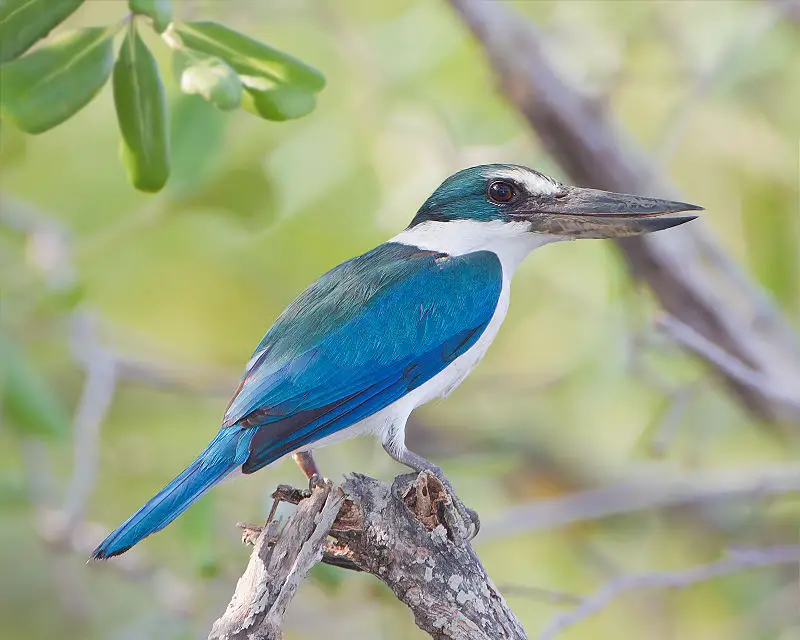
The Collared kingfisher is a medium-sized bird belonging to the Halcyoninae subfamily of tree kingfishers. It has a distinctive white collar and black mask that set it apart from other species in its family.
Its wide range extends from the Red Sea across southern Asia to Polynesia, making it one of the most widespread birds in the region.
The male and female collared kingfisher both have blue wings with dark barring, while juveniles are brownish grey with duller markings.
They feed mainly on fish, but can also be seen consuming crustaceans, reptiles, insects and small mammals when available.
This species nests inside cavities or tunnels near riverbanks or swamps created by their powerful bills; they often dig these themselves if there aren’t any existing ones nearby.
Despite being abundant throughout much of its range, this beautiful bird’s population numbers appear to be declining due to habitat destruction caused by human activity such as deforestation and development projects along riversides which provide important nesting sites for them.Scientific classification:
| Kingdom | Animalia |
| Phylum | Chordata |
| Class | Aves |
| Order | Coraciiformes |
| Family | Alcedinidae |
| Subfamily | Halcyoninae |
| Genus | Todiramphus |
| Species | T. chloris |
Also Featured In: Birds of Goa, Beautiful Birds Found in Coron Island
14. Frogmouth
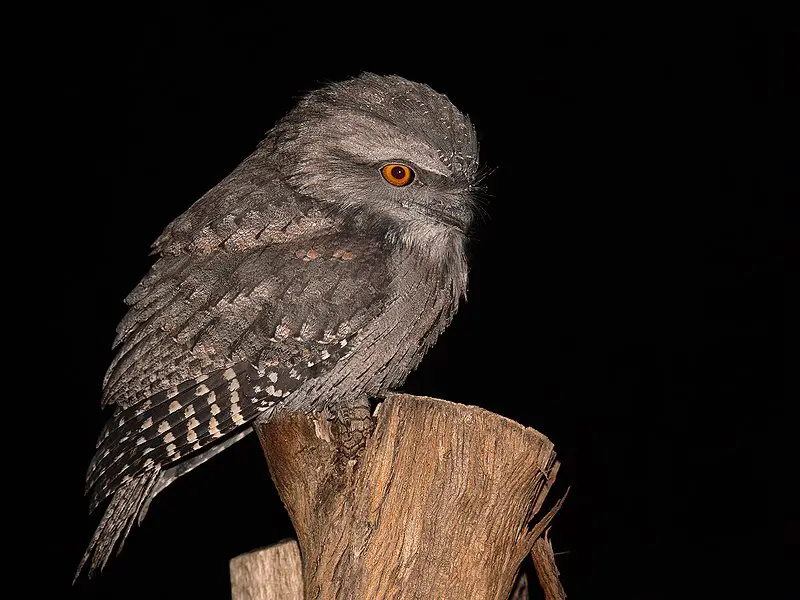
The Frogmouth is a nocturnal bird that belongs to the same family as owlet-nightjars, swifts and hummingbirds.
They have large flattened hooked bills with huge frog-like gape which helps them capture insects during night time.
Three species of Podargus are found in Australia and New Guinea only – they have massive eyes that allow for excellent night vision.
Their bodies are generally grey or brownish in colour with cryptic markings for camouflage when roosting during day light hours.
Generally known as quiet birds, their loud wailing call can be heard at dusk or dawn near river banks or wetlands where they live alone or form pairs throughout breeding season.
The diet of these fascinating creatures consists mainly of flying insects such as moths, beetles & cicadas etc., but on occasion will consume small vertebrates like lizards and frogs too.Scientific classification:
| Kingdom | Animalia |
| Phylum | Chordata |
| Class | Aves |
| Clade | Strisores |
| Order | Podargiformes Matthews, 1918 |
| Family | Podargidae Gray, 1847 |
Also Featured In: Birds that Charles Darwin Studied, Birds that Live around Victoria
15. Philippine Trogon
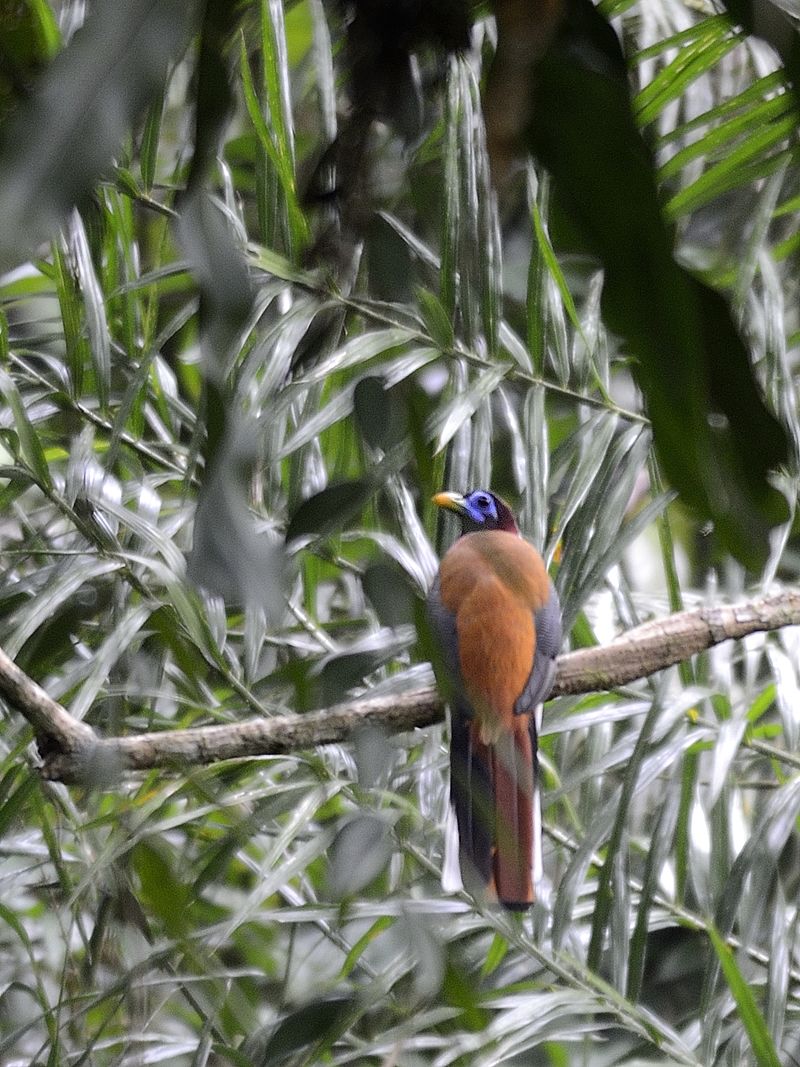
The Philippine trogon is a stunning bird, native to the Philippines. The male has a black head and throat, with blue on its face. Its neck and mantle are brown while its rump and tail are shades of red-brown.
The female’s colors are duller than her mate’s but still beautiful in their own right.
They inhabit subtropical or tropical moist lowland forests as well as montane forests up to 2200m elevation where they feed mainly on fruits such as figs along with insects that can be found among foliage or flying around them at dawn or dusk when they’re most active hunting for food.
These birds make their nests by drilling holes into trees which makes them unique compared to other Trogons who tend not to use this method for nesting.Scientific classification:
| Kingdom | Animalia |
| Phylum | Chordata |
| Class | Aves |
| Order | Trogoniformes |
| Family | Trogonidae |
| Genus | Harpactes |
| Species | H. ardens |
16. Philippine Megapode
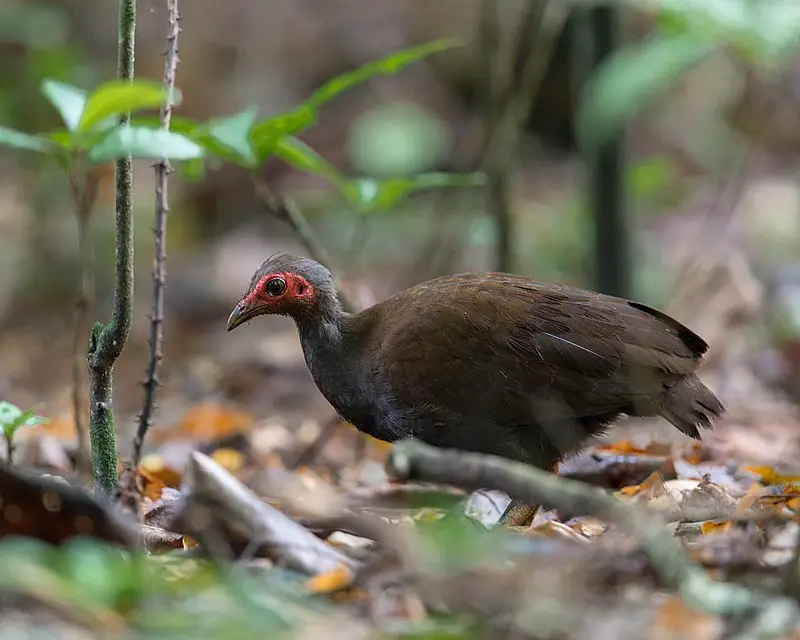
The Philippine Megapode is a species of bird found in the Philippines, northeastern Borneo and Sulawesi. It has an overall brown body colour with dark barring on its wings and tail feathers.
Its head is covered by light grey downy feathers while its legs are yellowish-orange in colour.
This ground dwelling bird prefers to inhabit subtropical or tropical dry forest, moist lowland forest as well as montane forests where it feeds on fruits, insects and small animals amongst other things.
As far as reproduction goes this species builds mound nests using materials such as leaves, twigs and soil which can reach up to four meters long.
They then lay their eggs within these mounds for incubation where the heat generated from decomposing vegetation helps keep them warm until they hatch a few months later into young chicks ready to explore their surroundings further.Scientific classification:
| Kingdom | Animalia |
| Phylum | Chordata |
| Class | Aves |
| Order | Galliformes |
| Family | Megapodiidae |
| Genus | Megapodius |
| Species | M. cumingii |
Also Featured In: Most Common Catanduanes Birds,
17. Pied Triller
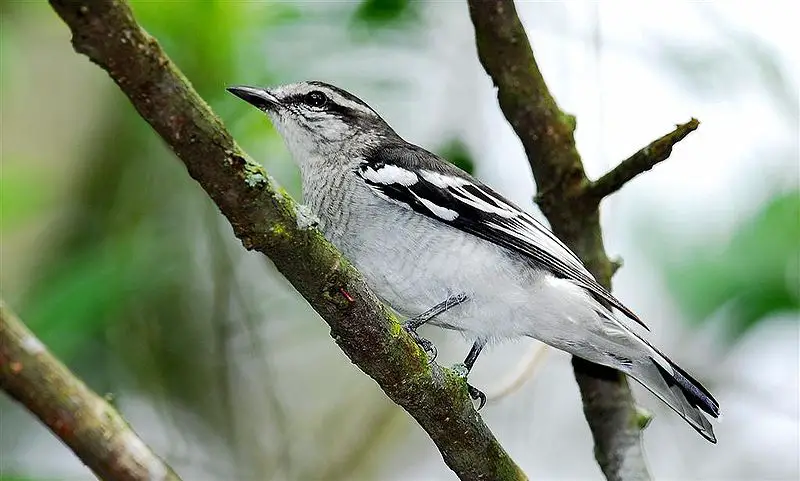
The Pied Triller is a species of bird found in parts of South East Asia. It belongs to the family Campephagidae and can be seen in Brunei, India, Indonesia, Malaysia, Philippines, Singapore and Thailand.
This black-and-white passerine has an eye patch that sets it apart from other birds its size. Its underparts are white with rufous upperparts and wings as well as grey crowns on both males and females giving them a unique look.
They mainly feed on insects but have also been observed eating fruits from trees or shrubs occasionally.
In terms of habitat they prefer forests but can adapt to secondary growth habitats too if needed for survival purposes making them quite adaptive creatures indeed.Scientific classification:
| Kingdom | Animalia |
| Phylum | Chordata |
| Class | Aves |
| Order | Passeriformes |
| Family | Campephagidae |
| Genus | Lalage |
| Species | L. nigra |
Also Featured In: Birds that Live in Kuala Lumpur, HDB Approved by Birds
18. Blue-Tailed Bee-Eater
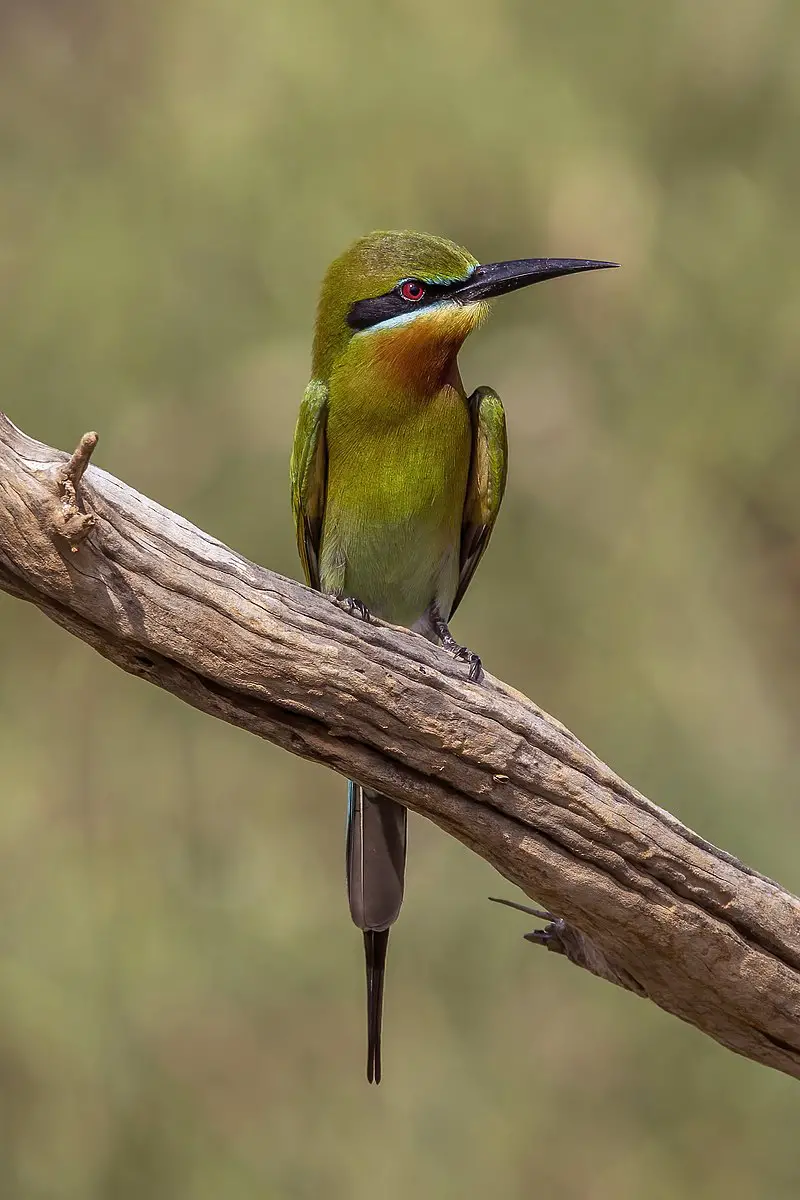
The Blue-tailed Bee-eater is a stunning bird found in South and Southeast Asia. This vibrant species has an iridescent blue tail, green back, yellow chest and white throat that stands out against the bright sky.
It feeds mainly on bees, wasps and other flying insects which it catches using its sharp beak while swooping through the air with remarkable agility.
The bee-eater typically nests by tunneling into loamy sand banks near rivers or streams to create burrows for their eggs.
During migration season they are often seen in large flocks soaring gracefully across the landscape seeking food sources before settling down in colonies during breeding season.
With its beautiful colours and graceful flight this impressive avian beauty captivates anyone lucky enough to see it up close.Scientific classification:
| Kingdom | Animalia |
| Phylum | Chordata |
| Class | Aves |
| Order | Coraciiformes |
| Family | Meropidae |
| Genus | Merops |
| Species | M. philippinus |
Also Featured In: Common Birds in Kerala, Birds that Migrate to Sri Lankan
19. Yellow-Breasted Fruit Dove
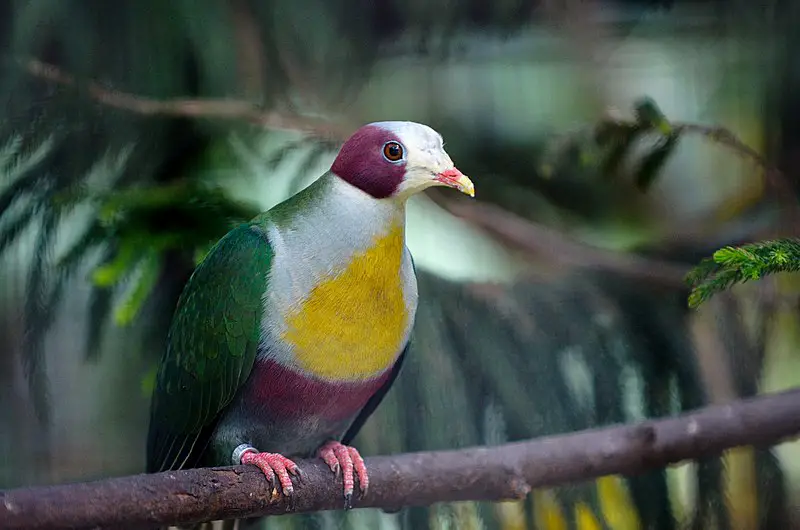
The Yellow-breasted fruit dove is a beautiful bird endemic to the Philippines. It lives in tropical moist lowland forests, however its population is declining due to habitat loss and illegal hunting or trapping for the wildlife trade.
This species has been listed as Least Concern by IUCN but conservation efforts are still needed if we want this species of bird survive.
The yellow-breasted fruit Dove has an overall yellowish colour with dark wings and tail feathers, red eyes and white spot on each side of their neck.
They feed mainly on fruits such as figs and berries which makes them important seed dispersers in their natural habitats while they also drink flower nectar like hummingbirds do.
Its illegal to hunt, capture or keep this lovely little creature so let’s all work together towards protecting it from extinction.Scientific classification:
| Kingdom | Animalia |
| Phylum | Chordata |
| Class | Aves |
| Order | Columbiformes |
| Family | Columbidae |
| Genus | Ptilinopus |
| Species | P. occipitalis |
20. Bukidnon Woodcock
The Bukidnon woodcock is a medium-sized wader native to the Philippines. It was only described as new to science in 2001, although specimens were collected from Luzon Island decades earlier and misidentified as Eurasian woodcocks’ samples.
The bird wasn’t recognized until 1993 when it was heard calling for the first time, followed by more specimen collections on Mindanao island two years later.
Its plumage varies between males and females; while both have dark brown upperparts with lighter spots, male’s head has reddish hues whereas female ones are greyer.
This species feeds mainly on earthworms but also consumes insects and spiders during wetter months of the year.Scientific classification:
| Kingdom | Animalia |
| Phylum | Chordata |
| Class | Aves |
| Order | Charadriiformes |
| Family | Scolopacidae |
| Genus | Scolopax |
| Species | S. bukidnonensis |
21. Apo Myna
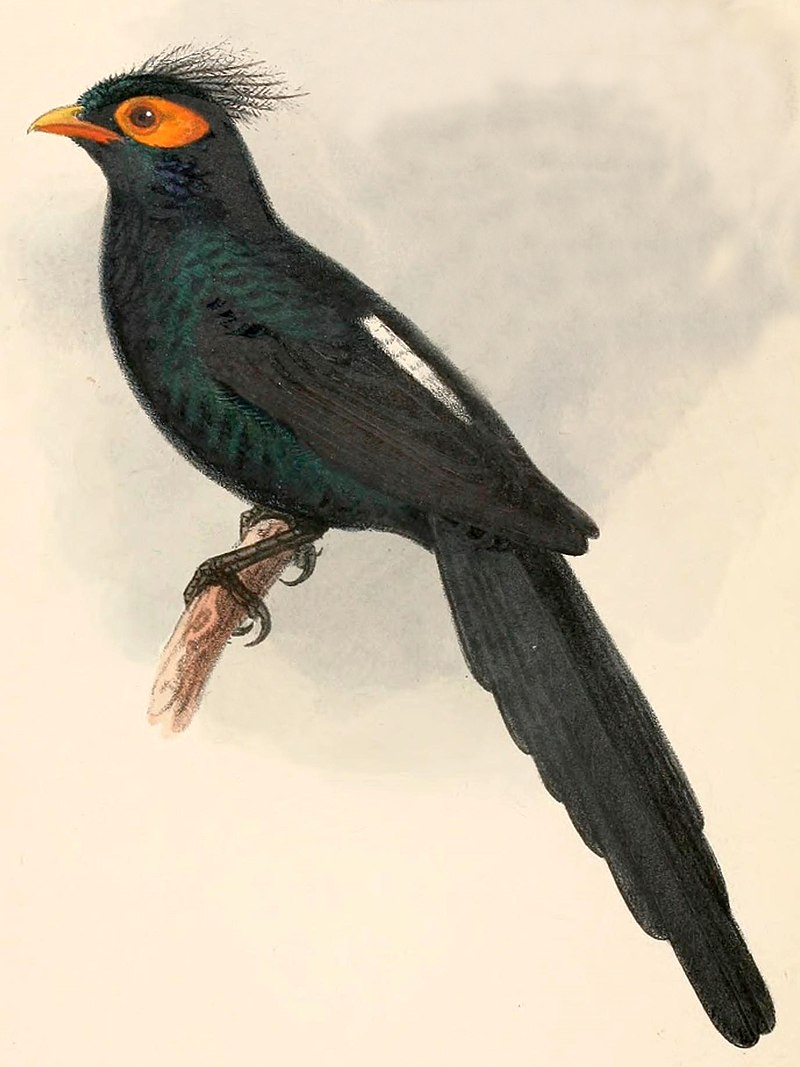
The Apo myna is a species of starling in the Sturnidae family, found only in Mindanao’s tropical montane forests.
It was previously classified under the genus Goodfellowia, which it is still known as today and also referred to as Mount Apo Starling or King Starling.
This bird has striking grey-black colouring with white spots on its wings and tail feathers. Its diet consists mainly of fruit supplemented by insects such as beetles, ants and grasshoppers.
Sadly, this species faces threat from deforestation due to expansion of agricultural land for crops like coffee beans which are grown commercially up in these areas; leading to loss of their natural habitat .
To save them from becoming extinct , conservation efforts should be made immediately so that future generations can continue admiring this beautiful creature.Scientific classification:
| Kingdom | Animalia |
| Phylum | Chordata |
| Class | Aves |
| Order | Passeriformes |
| Family | Sturnidae |
| Genus | Goodfellowia Hartert, 1903 |
| Species | G. miranda |
22. Philippine Pygmy Woodpecker
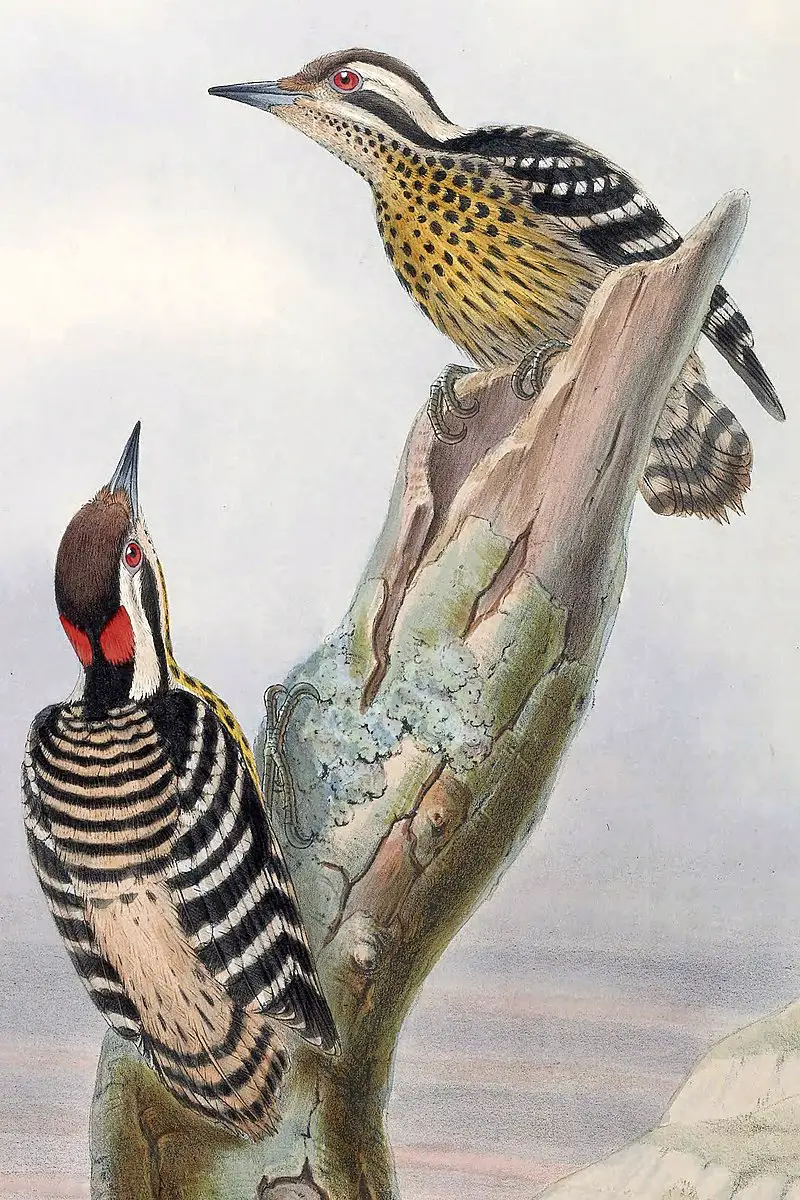
The Philippine pygmy woodpecker is a small species of bird in the Picidae family. It has three different subspecies, validirostris, maculatus and menagei.
These birds have blackish-brown feathers on their back that are moderately barred with white stripes, as well as a white throat which features a dark spot.
In Kapampangan they are called Anluage. They can be seen living in forests and woodlands mostly around the Philippines but also parts of Indonesia and Malaysia where there is suitable habitat for them to survive; such habitats include mangroves and coastal areas.
The Philippine pygmy woodpecker does not migrate due to its size so it remains within its area even during winter times when food sources become scarce or difficult to find because of snowfall or lack thereof.Scientific classification:
| Kingdom | Animalia |
| Phylum | Chordata |
| Class | Aves |
| Order | Piciformes |
| Family | Picidae |
| Genus | Yungipicus |
| Species | Y. maculatus |
23. Yellow-Vented Bulbul
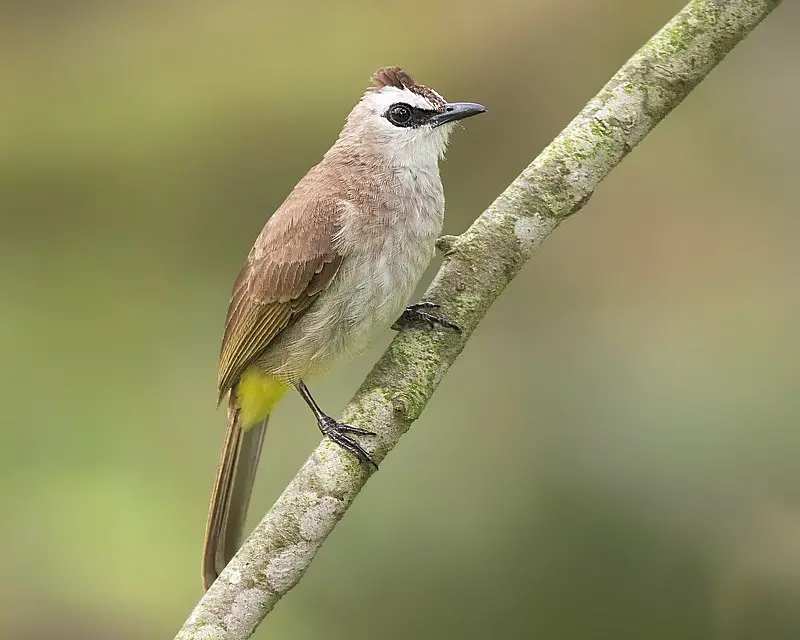
The Yellow-vented Bulbul is a stunning passerine bird from southeastern Asia, with its bright yellow and black plumage. It breeds in open habitats such as cultivated areas, but rarely enters deep forests.
They tend to be nomadic, wandering around and searching for food sources. During the breeding season they form pairs and build their nests at least two metres above ground level in trees or shrubs.
The female lays 2–4 eggs which are incubated by both parents over 13–14 days before hatching into chicks that fledge after 16–17 days of nestling stage..
These birds feed mainly on fruits or berries found in gardens or fields; insects like caterpillars may also make up part of their diet.
As beautiful as it looks, this species has a loud call which can become quite irritating if heard frequently.Scientific classification:
| Kingdom | Animalia |
| Phylum | Chordata |
| Class | Aves |
| Order | Passeriformes |
| Family | Pycnonotidae |
| Genus | Pycnonotus |
| Species | P. goiavier |
Also Featured In: Native Birds Of Ko Chang District, Ko Samet Birds You Need To Know
24. Writhed Hornbill
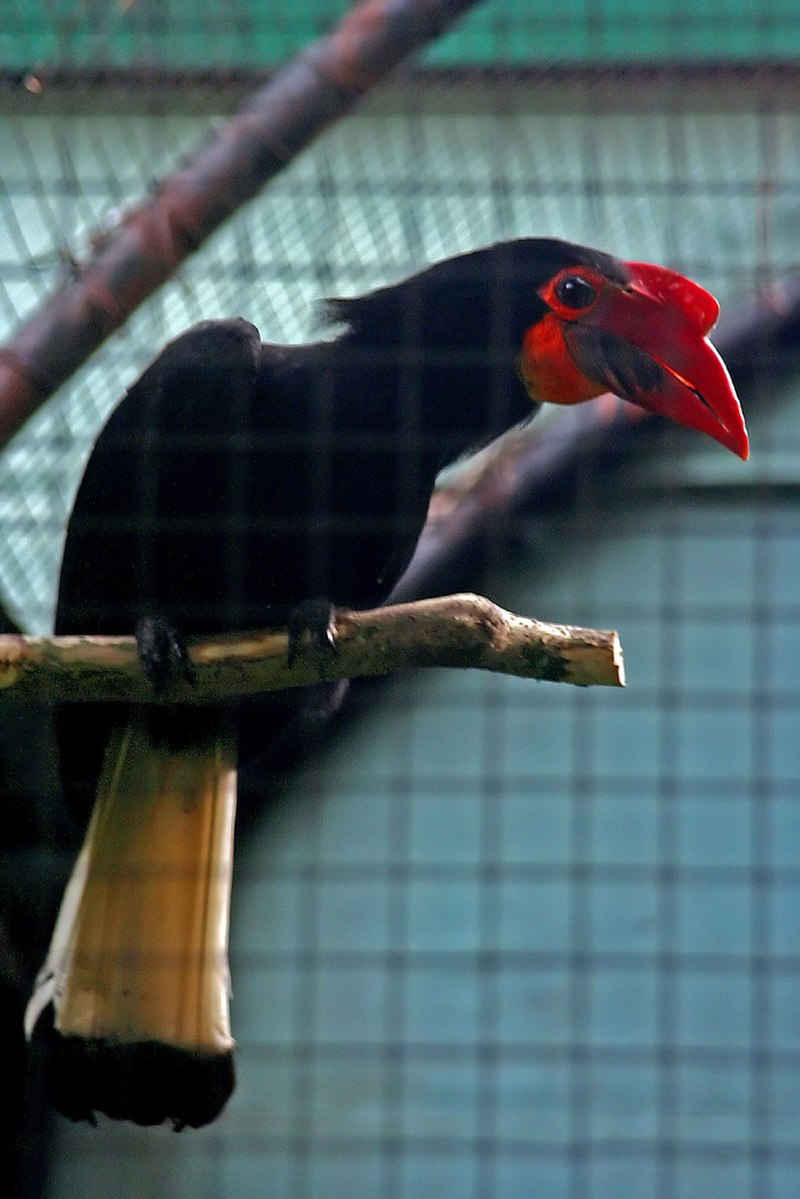
The Writhed Hornbill is a beautiful species of hornbill, that can only be found in the humid forests on the Philippine islands of Mindanao, Dinagat and Camiguin Sur.
It’s one of two species with orange-red throat and peri orbital skin patches; both males and females have this unique coloration which makes them stand out from other hornbills.
They also have distinctive long curved bills that give them their name – writhed referring to its twisted shape.
This bird has blackish-gray feathers on its head and body while holding white scalloped stripes along their wings and tail.
The diet consists mainly of fruits, insects, small reptiles as well as amphibians. These birds are very important for pollination in tropical forests making it vital to conserve these areas so they remain safe havens for these remarkable creatures..Scientific classification:
| Kingdom | Animalia |
| Phylum | Chordata |
| Class | Aves |
| Order | Bucerotiformes |
| Family | Bucerotidae |
| Genus | Rhabdotorrhinus |
| Species | R. leucocephalus |
25. Black-Naped Oriole
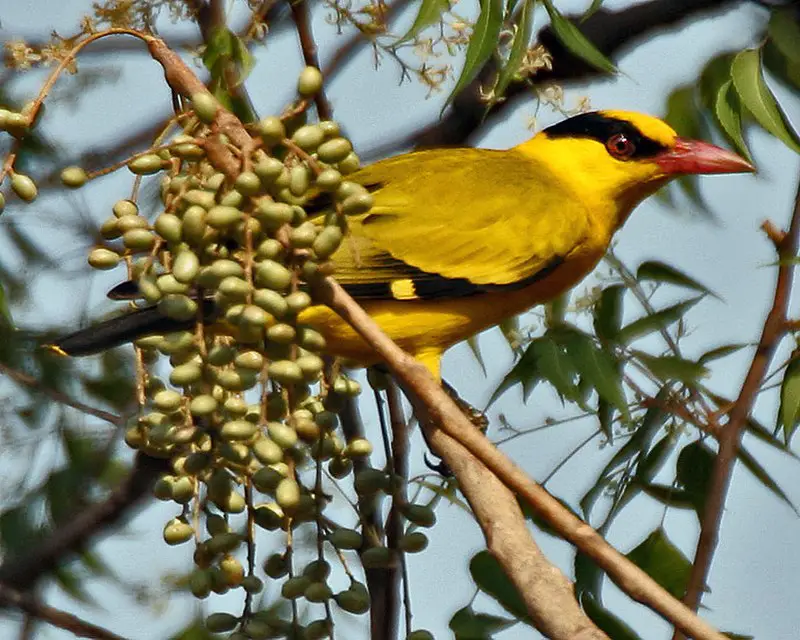
The Black-naped Oriole is a stunning bird native to Asia. It has bright yellow feathers with black markings on its head, wings and tail. Its beak and legs are also black in colour.
These birds can grow up to 25 cm long and they have very distinctive eye stripes – the eye stripe of this species is broader than that of the Indian Golden Oriole.
They mostly inhabit forests as well as open areas such as grasslands, orchards and gardens where there are plenty of trees for them to feed on insects or fruits like figs, dates and berries.
The Black-naped Orioles live in small flocks during their nonbreeding season but become solitary when breeding begins which usually occurs between March and May each year depending upon location.Scientific classification:
| Kingdom | Animalia |
| Phylum | Chordata |
| Class | Aves |
| Order | Passeriformes |
| Family | Oriolidae |
| Genus | Oriolus |
| Species | O. chinensis |
Also Featured In: Hong Kong Birds You Need to See,
26. Calayan Rail
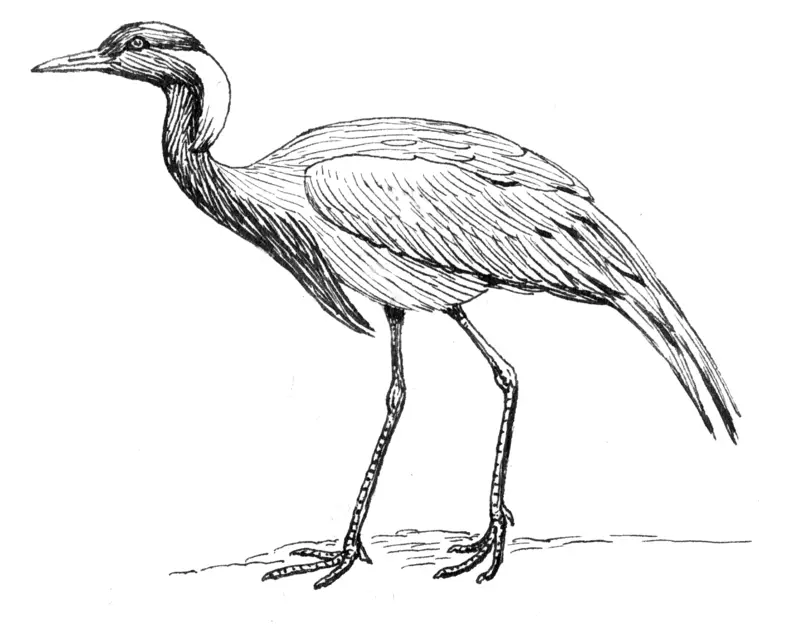
The Calayan rail is a unique bird found only on the island of Calayan in the Philippines. It belongs to the family Rallidae, which also includes moorhens and coots.
Known locally as ‘piding’, it was first observed by ornithologist Carmela Española in 2004 and officially announced later that year.
The flightless bird has distinct reddish-brown plumage with black barring all over its body, along with yellow eyes and bill, giving it an unmistakable appearance among other birds native to this region.
Its diet consists mainly of small invertebrates such as insects, worms or crabs but can occasionally feed on fruits from trees when available near water sources like ponds or streams where they forage for food during morning hours.
This endangered species needs our protection so we must strive towards preserving their natural habitat for future generations.Scientific classification:
| Kingdom | Animalia |
| Phylum | Chordata |
| Class | Aves |
| Order | Gruiformes |
| Family | Rallidae |
| Genus | Aptenorallus Kirchman, McInerney, Giarla, Olson, Slikas, and Fleischer, 2021 |
| Species | A. calayanensis |
27. Pink-Necked Green Pigeon
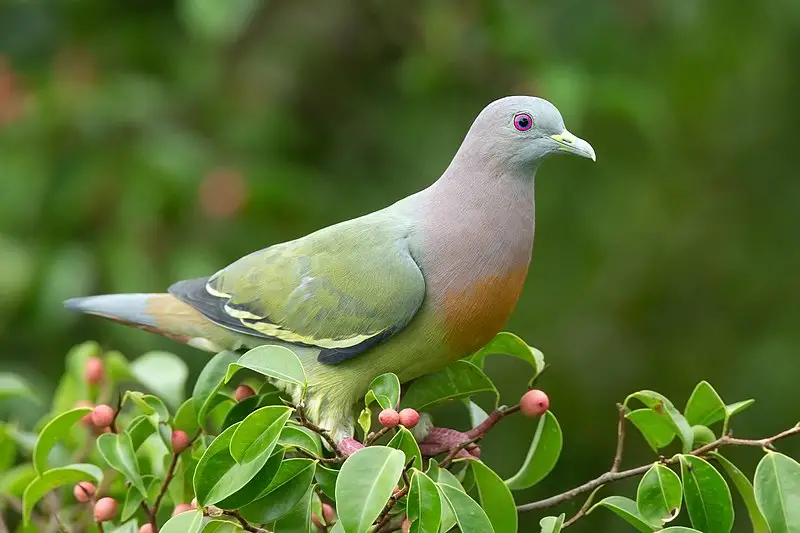
The Pink-necked green pigeon is a beautiful bird of the Columbidae family, native to Southeast Asia. Its body is mainly covered with emerald feathers and only the male has an eye-catching pink neck.
It can be found from Myanmar and Vietnam down to Indonesia and even in parts of Philippines, where it’s known as “punay”.
This medium sized species loves feeding on fruits such as figs or guavas but also enjoys snacking on insects from time to time.
In its natural habitat, this colorful avian often nests high up in trees for better protection against predators.
All in all, the unique beauty of Pink-necked Green Pigeon makes it one truly remarkable bird.Scientific classification:
| Kingdom | Animalia |
| Phylum | Chordata |
| Class | Aves |
| Order | Columbiformes |
| Family | Columbidae |
| Genus | Treron |
| Species | T. vernans |
Also Featured In: Birds That Live In Siquijor, Most Common Birds of Ko Samui
28. Luzon Bleeding-Heart
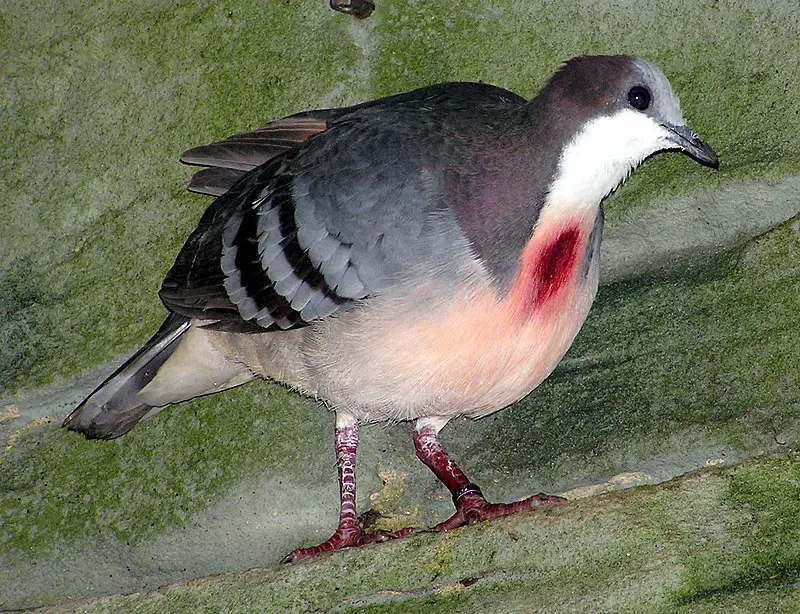
The Luzon bleeding-heart is a species of ground dove native to the Philippines. It has an unmistakable appearance, featuring white feathers with dramatic red patches on its breast and belly that resemble drops of blood.
This unique feature has earned it the name “bleeding heart,” as well as other more poetic names like “stabbed pigeon.”
The bird also stands out for its beautiful song, which can be heard early in the morning or late in the evening when they are most active.
Its diet consists mostly of seeds and insects found among low vegetation near rivers, swamps, meadows and grasslands – habitats where it breeds during rainy season months between May and August.Scientific classification:
| Kingdom | Animalia |
| Phylum | Chordata |
| Class | Aves |
| Order | Columbiformes |
| Family | Columbidae |
| Genus | Gallicolumba |
| Species | G. luzonica |
29. Philippine Hanging Parrot
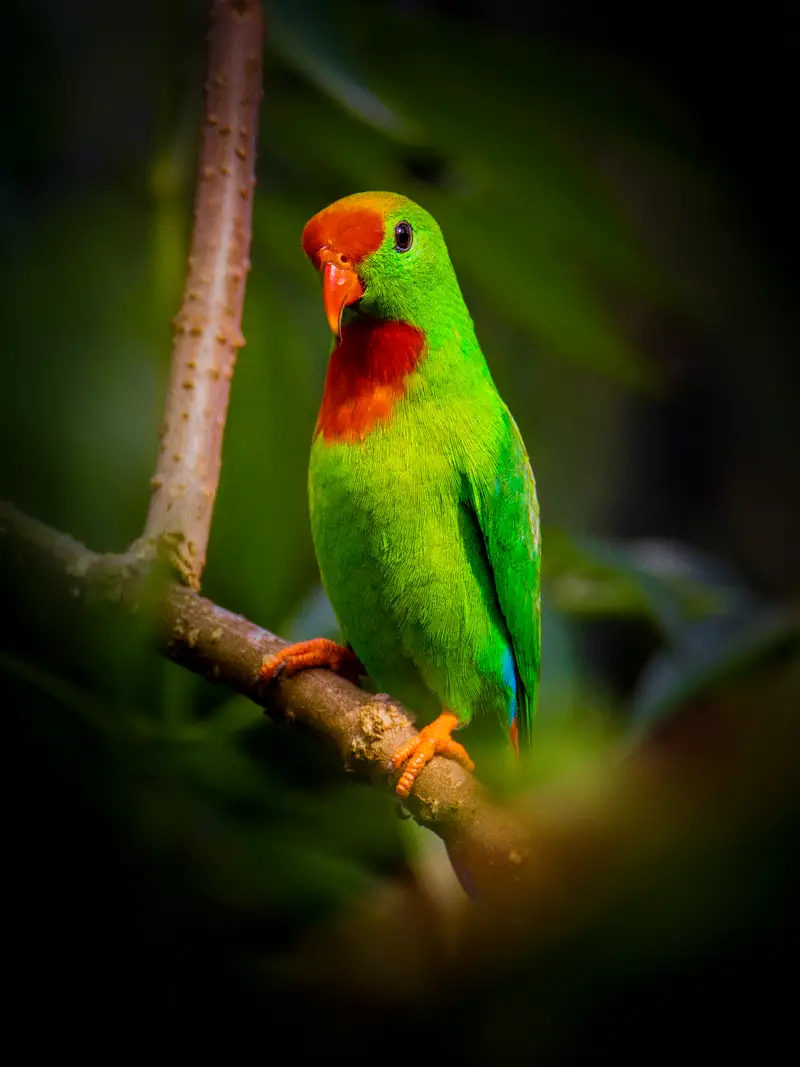
The Philippine Hanging Parrot is a small, psittaculid parrot species found in the Philippines. It has 11 subspecies, one of which may be distinct from the others.
The bird is known by its local Tagalog name ‘Kulasisi’. This beautiful bird can usually be seen hanging upside down on thin branches or vines and feeds mainly on fruits and flowers.
Despite being listed as Least Concern by IUCN, some of its subspecies are under threat due to deforestation and illegal trapping for pet trade.
Conservation efforts must therefore be taken to ensure their survival in the wild.Scientific classification:
| Kingdom | Animalia |
| Phylum | Chordata |
| Class | Aves |
| Order | Psittaciformes |
| Family | Psittaculidae |
| Genus | Loriculus |
| Species | L. philippensis |
30. Mindanao Hornbill
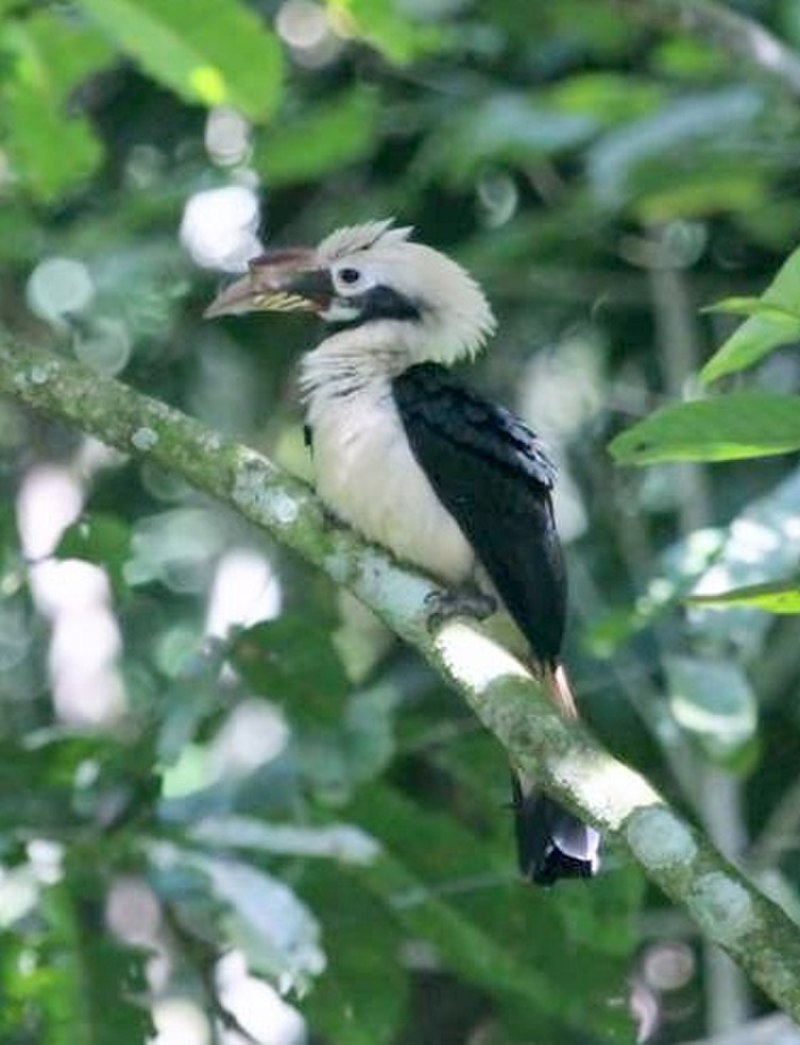
The Mindanao hornbill is a medium-sized species of bird found in the rainforests of Mindanao, Dinagat, Siargao and Basilan. It belongs to the Philippine tarictic hornbill family, having been previously classified as a subspecies of P. panini.
The Samar Hornbill is also included under this classification. These birds are characterized by their large bill with bright yellow or orange casques on top and black plumage throughout its body.
They have long wings which they use for flight but mainly feed from branches while perched on trees due to their short legs which make walking difficult.
Their diet consist mostly of fruits and insects that can be reached up high in tree canopies where they usually nest too – often making loud calls during mating season so potential mates could hear them clearly.Scientific classification:
| Kingdom | Animalia |
| Phylum | Chordata |
| Class | Aves |
| Order | Bucerotiformes |
| Family | Bucerotidae |
| Genus | Penelopides |
| Species | P. affinis |
31. Chestnut-Breasted Malkoha
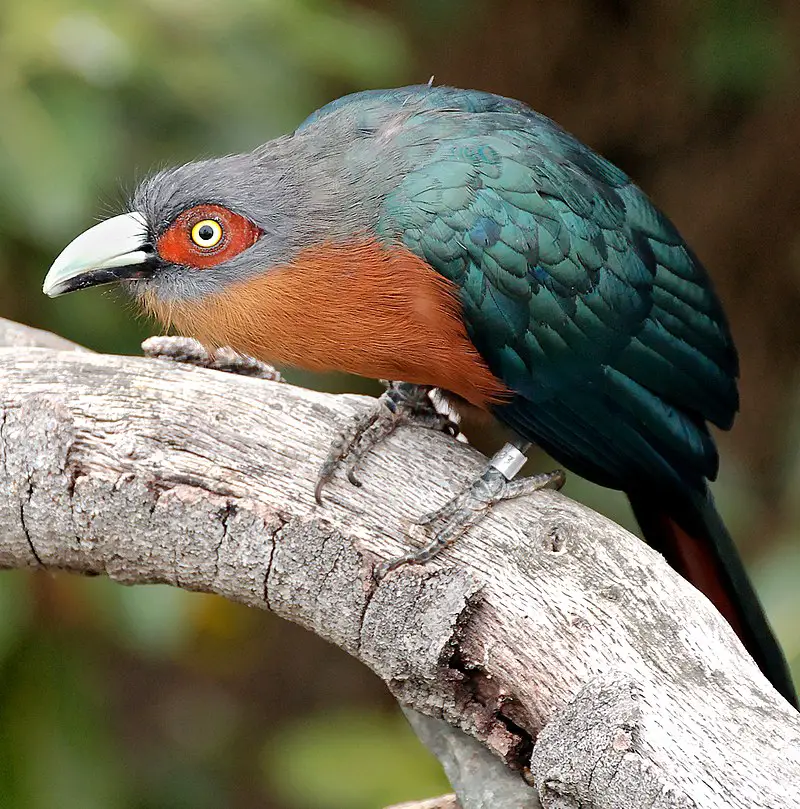
The Chestnut-breasted malkoha is a species of cuckoo found in Southeast Asia, ranging from Myanmar to eastern Java, the Philippines and Borneo.
It stands out among other birds with its large size – measuring up to 49 cm (19 inches) – and striking coloration: grey and dark green upperparts contrasted by chestnut underparts.
Males and females look alike, featuring curved pale upper mandibles. This bird does not exhibit typical cuckoo behaviour like egg laying; instead it eats mainly fruit but also hunts for insects on occasion.
The Chestnut-breasted malkoha is an impressive sight that brightens up any jungle or forest environment.Scientific classification:
| Kingdom | Animalia |
| Phylum | Chordata |
| Class | Aves |
| Order | Cuculiformes |
| Family | Cuculidae |
| Genus | Phaenicophaeus |
| Species | P. curvirostris |
32. Spotted Imperial Pigeon

The Spotted imperial pigeon is a species of bird found in the Philippines. It has grey neck and wings, with white spots on its feathers.
Endemic to this region, it can be seen living near forests and forest edges as well as limestone shorelines where they feed.
Unfortunately due to habitat loss and hunting these birds are classified vulnerable today making them an endangered species.
Hunting or capturing these pigeons is illegal by law so we must do our best to protect them from extinction if possible.
We should make sure their natural habitats remain protected for future generations of this beautiful bird.Scientific classification:
| Kingdom | Animalia |
| Phylum | Chordata |
| Class | Aves |
| Order | Columbiformes |
| Family | Columbidae |
| Genus | Ducula |
| Species | D. carola |
33. Southern Silvery Kingfisher
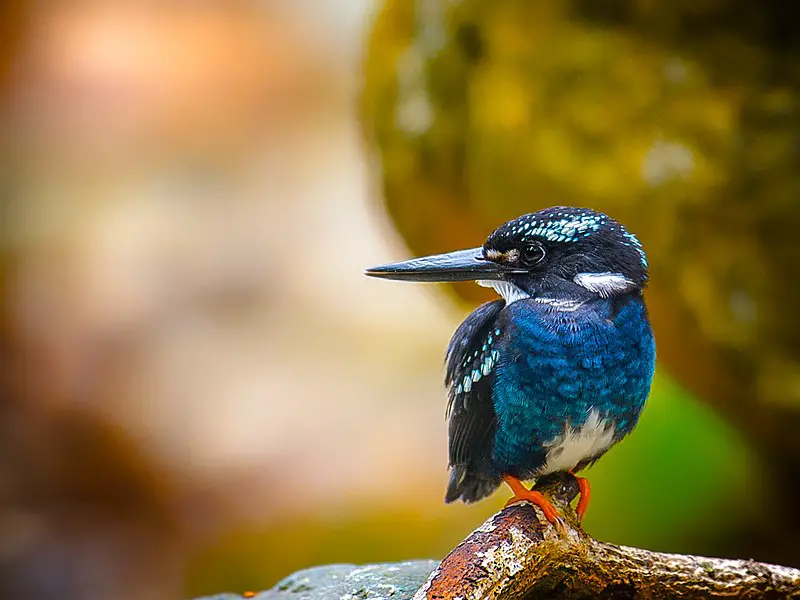
The Southern silvery kingfisher (Ceyx argentatus) is a species of bird that can only be found in the Philippines. It inhabits tropical moist lowland forests, streams and rivers located on Mindanao and Basilan Islands.
This stunning species was formerly considered to belong with the Northern silvery kingfisher from Visayas before being recognised as its own separate kind.
The beautiful blue-green colouring combined with white underparts make this tiny creature stand out among other birds of similar size.
Sadly, it is threatened due to habitat destruction which means conservation efforts are essential for its survival into the future.Scientific classification:
| Kingdom | Animalia |
| Phylum | Chordata |
| Class | Aves |
| Order | Coraciiformes |
| Family | Alcedinidae |
| Subfamily | Alcedininae |
| Genus | Ceyx |
| Species | C. argentatus |
Also Featured In: Silver Birds You Should Know,
34. Chestnut Munia
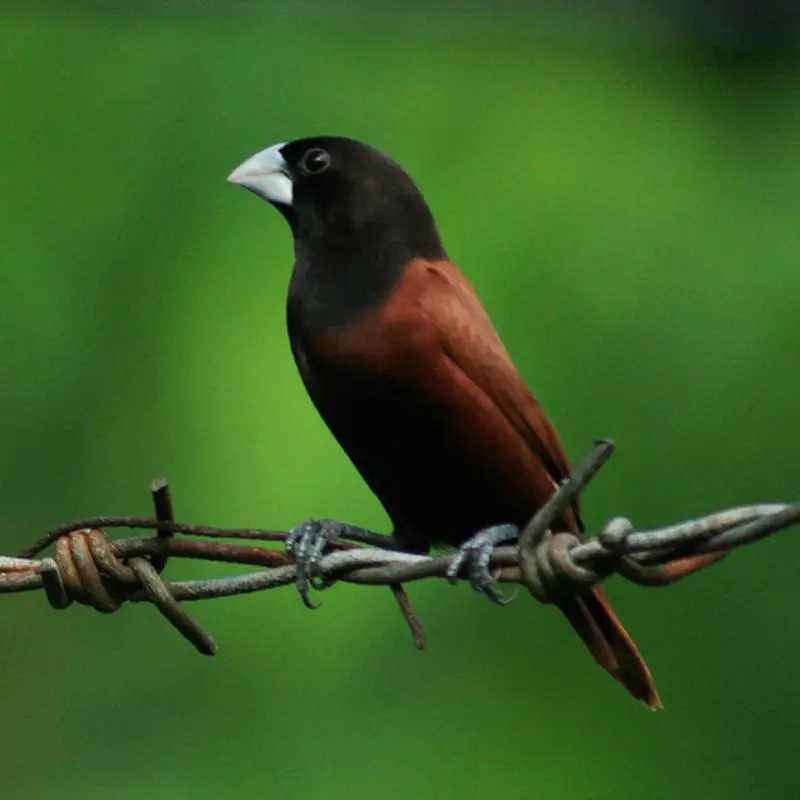
The Chestnut munia is a small passerine bird found in many parts of Asia. It has a glossy black head, chest and wings with white patches along its back and belly.
Its bill is conical shaped while the eyes are dark brown to blackish colored. This species can be seen foraging on grasslands, wet fields or around farmlands where it eats various kinds of grains, insects and sometimes weeds too.
Breeding pairs form during summer season when they construct nests using grasses which are placed near shrubs or trees.
A clutch consists of 2-6 eggs that have greyish-white coloration with blotched markings at times.
The female incubates them for about 11 days before hatching takes place after which both parents feed their young ones until they fledge out from the nest within 16–21 days post hatch date.Scientific classification:
| Kingdom | Animalia |
| Phylum | Chordata |
| Class | Aves |
| Order | Passeriformes |
| Family | Estrildidae |
| Genus | Lonchura |
| Species | L. atricapilla |
35. Azure-Breasted Pitta
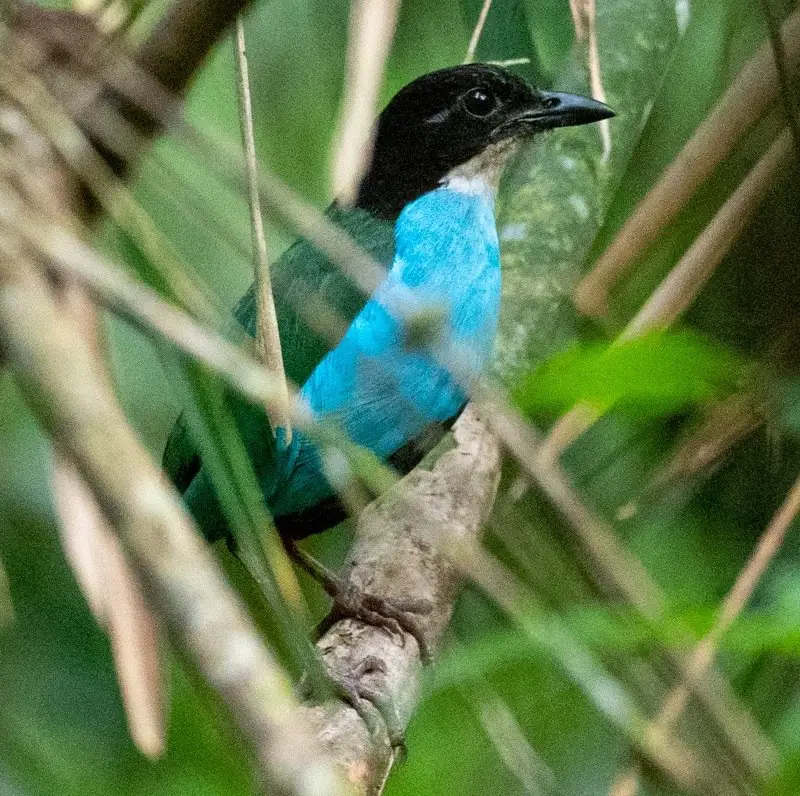
The Azure-breasted pitta is a strikingly beautiful bird found in the Philippines. It has stunning colors of azure, red, black and white.
The species is classified as endangered due to habitat loss and can only be seen within its natural environment of tropical moist lowland forests on Mindanao, Bohol, Leyte and Samar islands.
Measuring at medium size with an elongated body shape it forages for insects among leaves or on the ground occasionally taking short flights from tree to tree when disturbed.
Despite not being able to survive outside of protected areas this species still brings joy through its vibrant beauty which will hopefully remain around for many years more.Scientific classification:
| Kingdom | Animalia |
| Phylum | Chordata |
| Class | Aves |
| Order | Passeriformes |
| Family | Pittidae |
| Genus | Pitta |
| Species | P. steerii |
36. Plain Bush-Hen
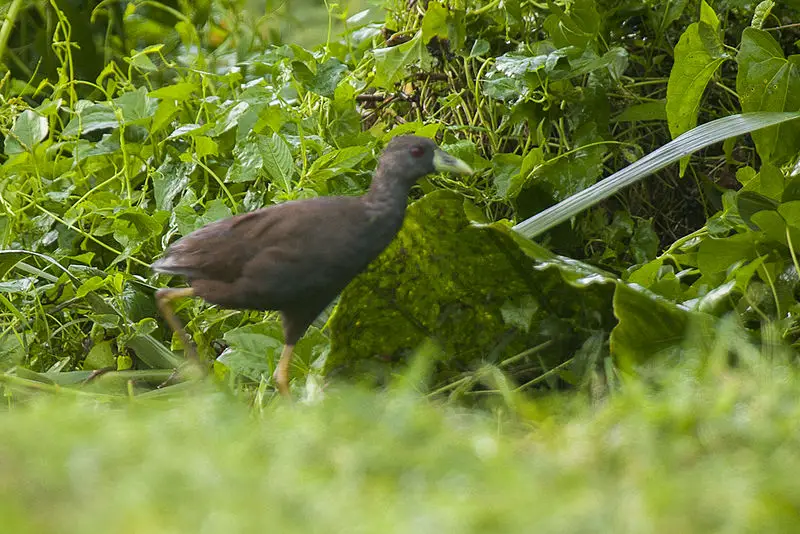
The Plain bush-hen is a species of bird in the Rallidae family, found only in The Philippines. It has an olive-brown color with pale yellow underparts and black barring on its wings, tail and head.
Its bill is short and thick while legs are long for wading through shallow water to find food like small invertebrates, seeds or fruits.
They usually stay close to bodies of water such as swamps or marshes where they can hide from predators by standing very still among tall grasses or vegetation when danger approaches.
During breeding season males attract females with loud calls repeated several times throughout the day which help them pair up easily but nest sites remain hidden since these birds build their nests low on ground next to dense bushes providing excellent camouflage against potential threats.Scientific classification:
| Kingdom | Animalia |
| Phylum | Chordata |
| Class | Aves |
| Order | Gruiformes |
| Family | Rallidae |
| Genus | Amaurornis |
| Species | A. olivacea |
37. Spotted Wood Kingfisher
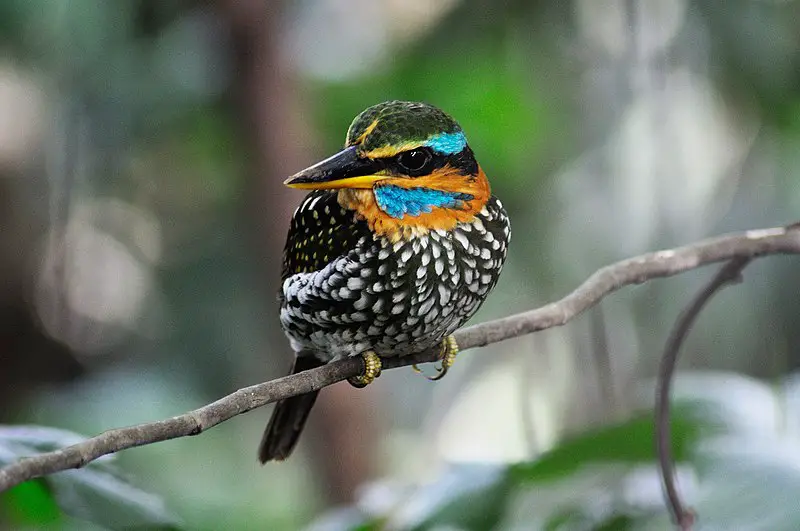
The Spotted wood kingfisher is an eye-catching bird native to the Philippines. It has a vibrant plumage of blue, black and white with distinctive spots on its wings and tail feathers.
This species stands out from other Philippine kingfishers due to its size; it measures around 10 inches in length.
The Spotted wood kingfisher lives mainly in subtropical or tropical moist lowland forests where they feed on fish, frogs and insects among others.
These birds are usually found near lakes, rivers or streams as they need water sources for hunting prey items which require diving into the water surface often times doing so multiple times per day.
Conservation efforts have been put forth by various organizations as this species population is threatened by deforestation caused by humans activities such as urbanization, logging etcScientific classification:
| Kingdom | Animalia |
| Phylum | Chordata |
| Class | Aves |
| Order | Coraciiformes |
| Family | Alcedinidae |
| Subfamily | Halcyoninae |
| Genus | Actenoides |
| Species | A. lindsayi |
38. Negros Bleeding-Heart Pigeon
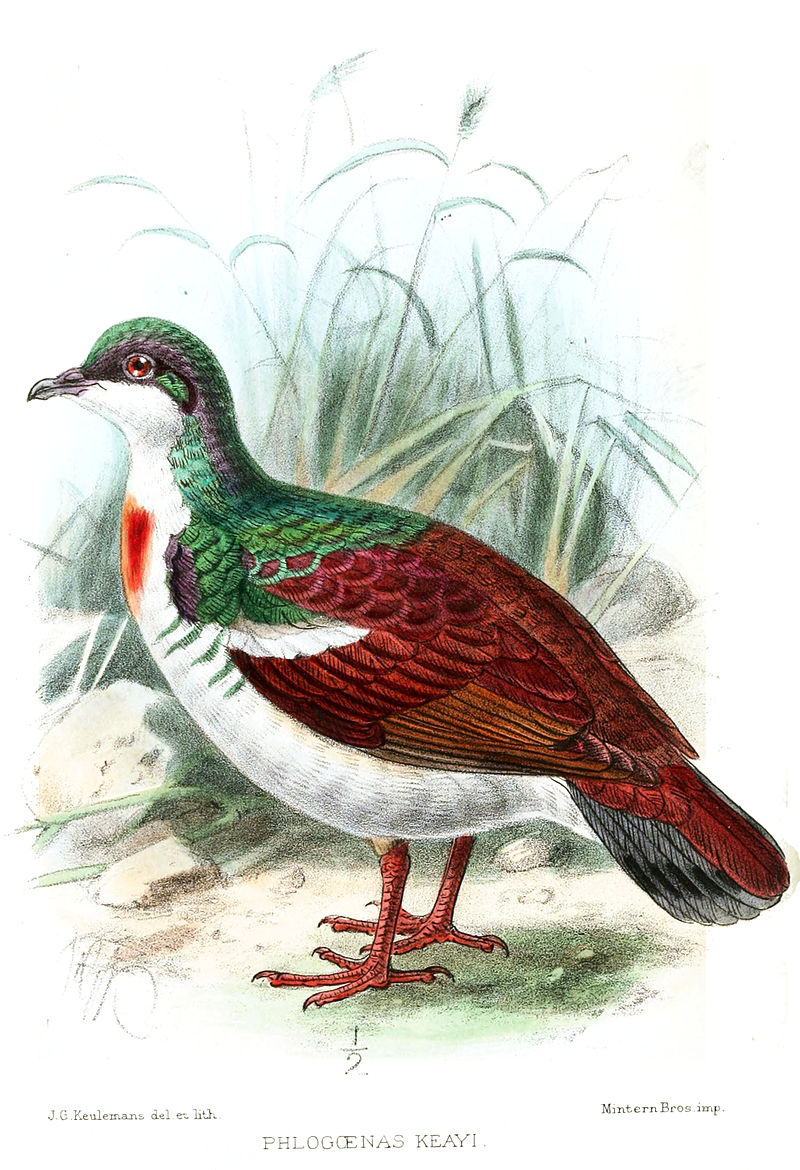
The Negros bleeding-heart pigeon is an endangered bird endemic to the Philippines. This species has a small population of only 50 – 249 mature individuals and its habitat on the islands of Negros and Panay continues to decline due to ongoing forest loss.
It is characterized by its reddish chest which gives it its name, in addition to having brown feathers with white spots scattered throughout their bodies.
The birds are known for being shy and elusive as well as living in dense forests where they feed on fruit, seeds, buds, flowers, snails and other insects found there.
Conservation efforts should be taken seriously if this unique species is going to survive into future generations.Scientific classification:
| Kingdom | Animalia |
| Phylum | Chordata |
| Class | Aves |
| Order | Columbiformes |
| Family | Columbidae |
| Genus | Gallicolumba |
| Species | G. keayi |
39. Black-Chinned Fruit Dove
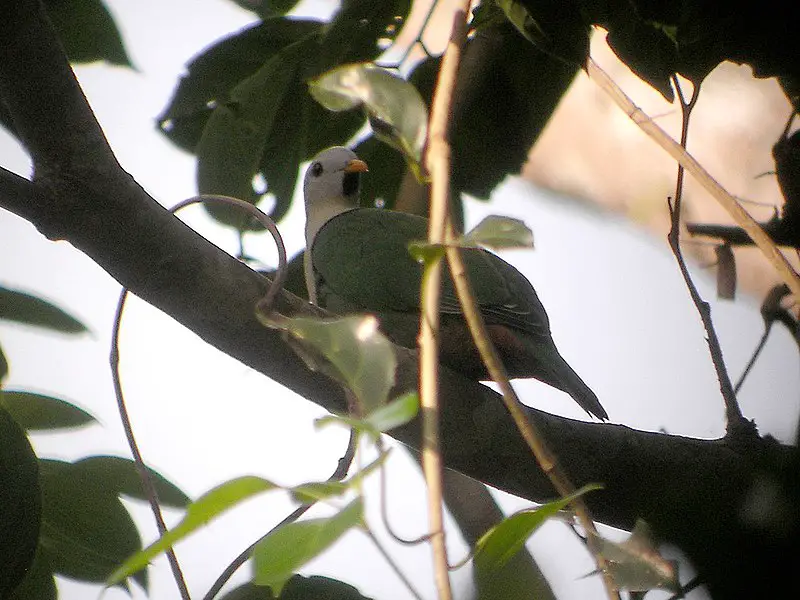
The Black-chinned Fruit Dove is a stunningly beautiful bird with its vibrant colors and unique features.
Males have green bellies, wings, and tails; whitish grey heads and necks with purple bases; red irises; yellow bills with small black patches underneath.
Females have green heads, necks, backs of the head to the tail feathers which are dark brown in color.
This species can grow up to 27 cm long making it medium sized for a dove species. They inhabit lowland forests from northern India throughout Southeast Asia as far north as Taiwan where they feed on fruits like figs along with some insects too.
These birds usually travel alone or in pairs during their migrations but flocks may also form when food sources become available at certain times of year.Scientific classification:
| Kingdom | Animalia |
| Phylum | Chordata |
| Class | Aves |
| Order | Columbiformes |
| Family | Columbidae |
| Genus | Ptilinopus |
| Species | P. leclancheri |
Also Featured In: Most Common Birds of Lubang Island,
40. Palawan Hornbill
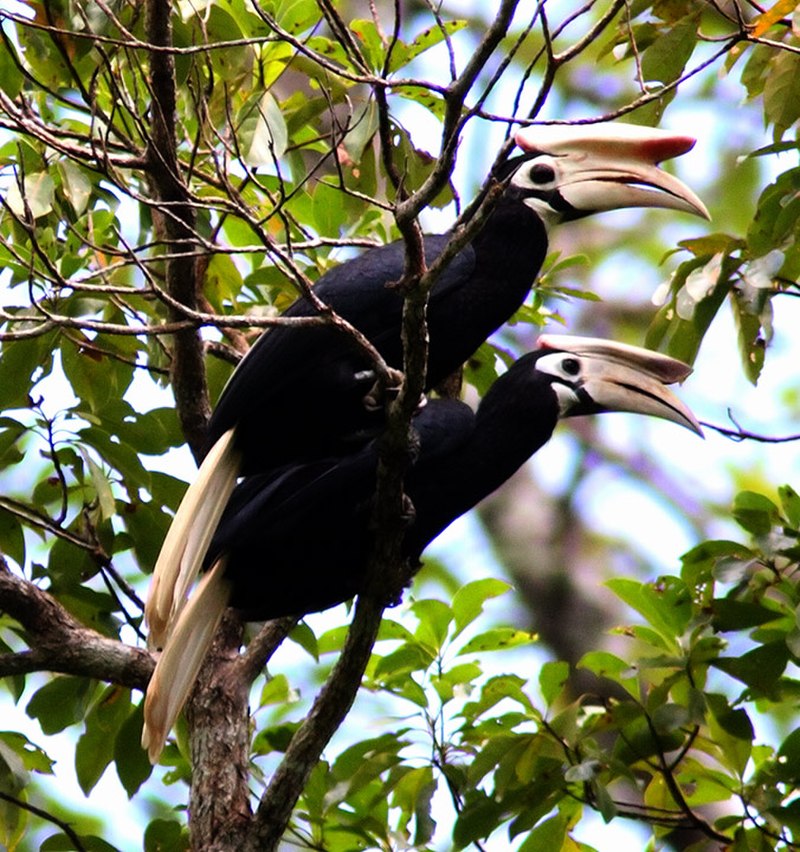
The Palawan hornbill is a majestic bird endemic to the Philippines. It can be found in Palawan and some nearby islands such as Balabac, Busuanga, Calauit, Culion and Coron.
This large forest bird has been given the local name of talusi by Cuyunon people. Sadly it’s threatened due to habitat loss caused by humans activities like hunting and trapping for cage-bird trade.
Conservation efforts are being made so that this species doesn’t become extinct in our lifetime. We must all do what we can to protect these beautiful creatures before they disappear forever from their natural habitats.Scientific classification:
| Kingdom | Animalia |
| Phylum | Chordata |
| Class | Aves |
| Order | Bucerotiformes |
| Family | Bucerotidae |
| Genus | Anthracoceros |
| Species | A. marchei |
41. Brown Shrike
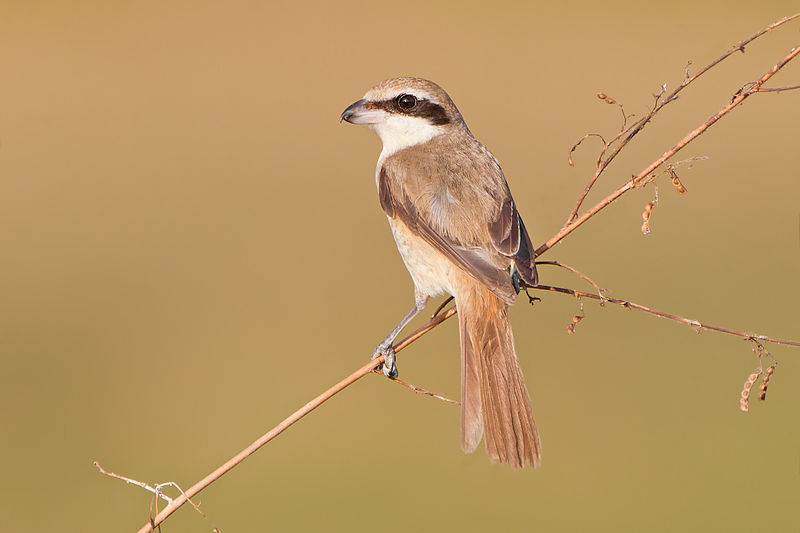
The Brown Shrike is a beautiful bird belonging to the shrike family, found mainly in Asia. It has a distinctive crest which gives it its Latin name ‘cristatus’.
They feed on insects and small vertebrates like lizards and mice, hence they are also called ‘butcher birds’.
These birds have brown upperparts with rufous wings, tail tipped white along with black mask through the eyes giving them an impressive look.
Despite their predatory nature these birds still remain quite popular amongst birdwatchers due to their vibrant colors and wide-ranging habitats across much of South East Asia making them easy targets for photography enthusiasts too.Scientific classification:
| Kingdom | Animalia |
| Phylum | Chordata |
| Class | Aves |
| Order | Passeriformes |
| Family | Laniidae |
| Genus | Lanius |
| Species | L. cristatus |
Also Featured In: Maldives birds, Urban Birds of Hong Kong
42. Indigo-Banded Kingfisher
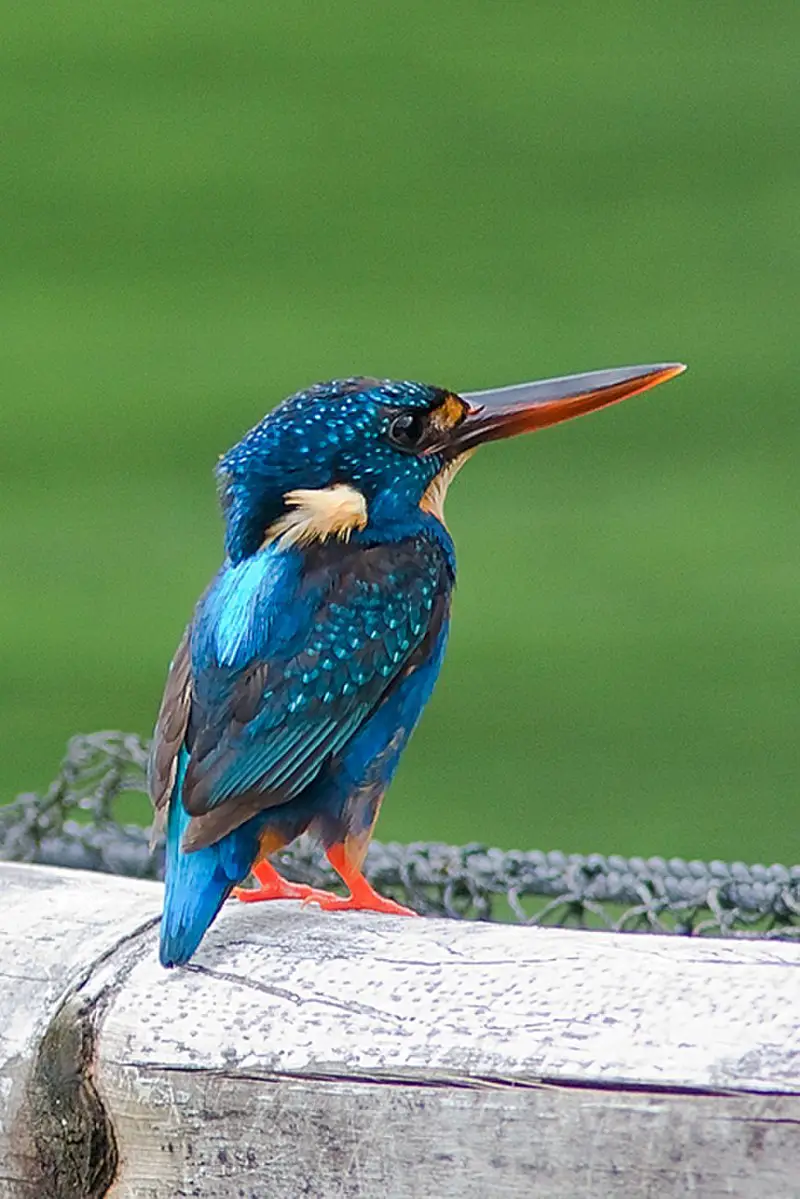
The Indigo-banded kingfisher is a species of bird belonging to the Alcedinidae family, found only in the Philippines. It has two subspecies – C. c. cyanopectus and C.
c nigriostris – which are generally uncommon but locally widespread across northern and central islands such as Luzon, Polillo, Mindoro, Sibuyan and Ticao; Panay; Negros respectively.
This vibrant yet small bird has striking plumage – predominantly blue with white patches on its wings along with an iridescent purple lower back that extends up to its head forming a crown like appearance giving it an air of regalness.
In terms of behavior they tend to be solitary birds preying mainly upon insects or small fish near rivers or ponds while perching atop branches close by allowing them ample opportunities for their characteristic dive bombing technique when hunting prey.Scientific classification:
| Kingdom | Animalia |
| Phylum | Chordata |
| Class | Aves |
| Order | Coraciiformes |
| Family | Alcedinidae |
| Subfamily | Alcedininae |
| Genus | Ceyx |
| Species | C. cyanopectus |
Also Featured In: Kingfishers Species, Most Common Birds in Negros
43. Negros Fruit Dove
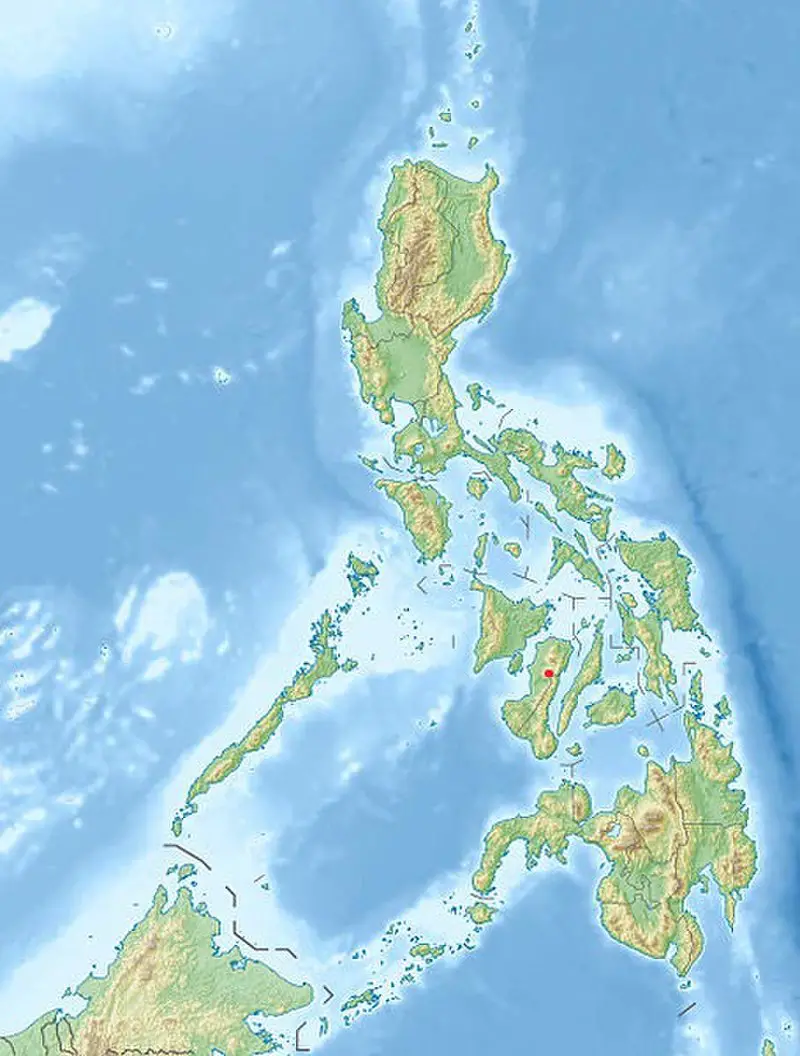
The Negros Fruit Dove is an endangered species of bird native to the island of Negros in the Philippines.
It was first discovered when a single female specimen was found on Mount Kanlaon, located in the northern part of the island.
Its overall plumage is bright yellow and green with reddish-brown wings and tail feathers. The dove feeds mainly on fruits such as papaya and banana, although it may also eat insects or other small animals occasionally.
Unfortunately, its population has been heavily impacted by logging activities that have caused much destruction to its habitat thus leading to a significant decline in numbers over time.
Conservation measures need to be taken soon if this beautiful species is going to survive into future generations.Scientific classification:
| Kingdom | Animalia |
| Phylum | Chordata |
| Class | Aves |
| Order | Columbiformes |
| Family | Columbidae |
| Genus | Ptilinopus |
| Species | P. arcanus |
Also Featured In: Pigeons Species,
44. Black Shama
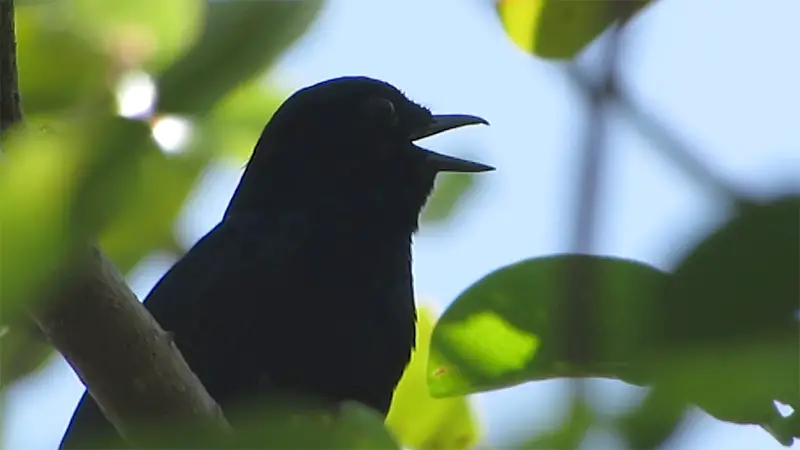
The Black shama, also known as “Siloy” to locals in the Philippines, is a bird that belongs to the Muscicapidae family. It can only be found on the island of Cebu, and is renowned for its beautiful black plumage.
This species is commonly found in subtropical or tropical moist lowland forests, as well as in shrublands and plantations.
They have been spotted in various locations across the island, with some locations being of particular importance.
Despite being endemic to Cebu, the Black shama is currently classified as “Vulnerable” on the IUCN Red List, largely due to the loss and degradation of their natural habitats.Scientific classification:
| Kingdom | Animalia |
| Phylum | Chordata |
| Class | Aves |
| Order | Passeriformes |
| Family | Muscicapidae |
| Genus | Copsychus |
| Species | C. cebuensis |
Also Featured In: Asian Birds,
45. Philippine Hawk-Cuckoo
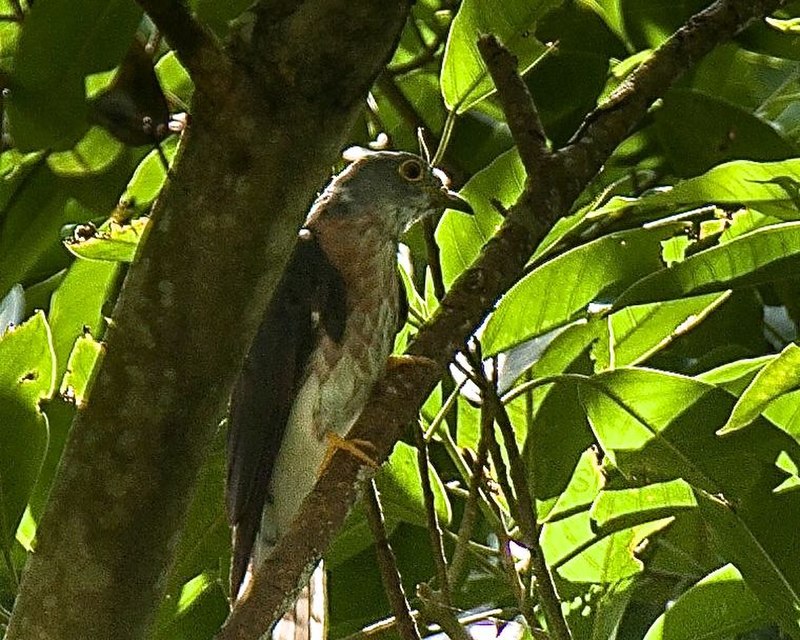
The Philippine hawk-cuckoo is a unique bird species found only in the Philippines. Initially classified as a subspecies of Hodgson’s hawk-cuckoo, it is now treated as a separate species due to vocalization differences.
This medium-sized cuckoo is approximately 29 centimeters long and has a dark-grey upper body and a white underbody.
The climate and environment of the Philippines are the only places where the Philippine hawk-cuckoo may be seen.
These birds are distinctive and valuable creatures that deserve attention and conservation efforts to protect their habitat and way of life.Scientific classification:
| Kingdom | Animalia |
| Phylum | Chordata |
| Class | Aves |
| Order | Cuculiformes |
| Family | Cuculidae |
| Genus | Hierococcyx |
| Species | H. pectoralis |
46. Luzon Boobook
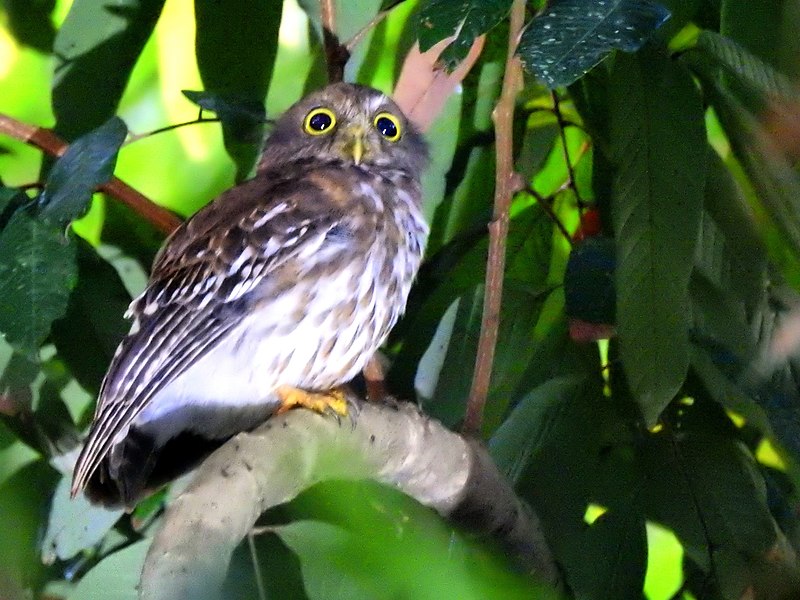
The Luzon boobook, also known as Luzon hawk-owl, is a small owl species found in forests in the Philippines. This bird has a brown and white mottled plumage and appears similar in males and females.
It belongs to the Strigidae family and is one of the tiniest owls in the Philippine hawk-owl group.
The owl’s distinctive features include white, eyebrow-like streaks above its eyes and beak. Being endemic to the Philippines, the Luzon boobook is exclusive to the country and does not occur elsewhere.
It is a nighttime predator and feeds on insects and small mammals. Although it inhabits forests, it may sometimes venture into cultivated areas in search of prey.
The Luzon boobook is a fascinating bird and an important part of the country’s biological diversity.Scientific classification:
| Kingdom | Animalia |
| Phylum | Chordata |
| Class | Aves |
| Order | Strigiformes |
| Family | Strigidae |
| Genus | Ninox |
| Species | N. philippensis |
47. Elegant Tit
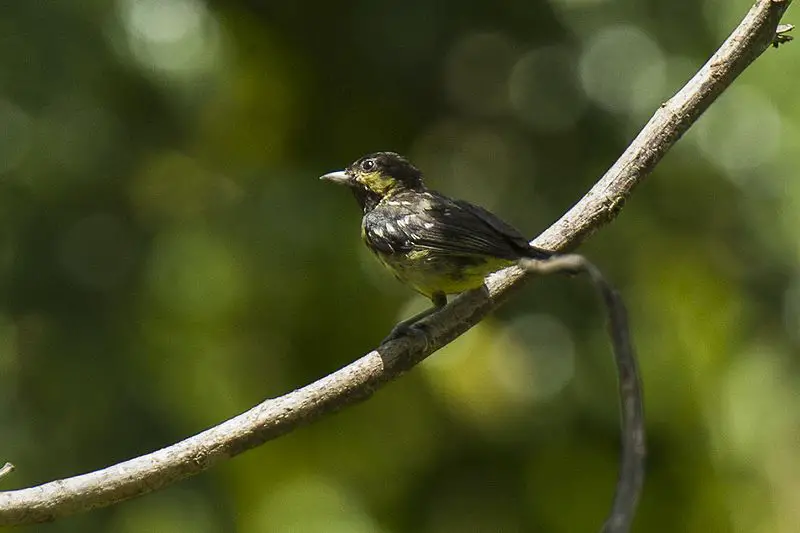
The Elegant tit bird is a beautiful species of tit that is found exclusively in the Philippines. Formerly classified under the Parus genus, it was subsequently reclassified under Pardaliparus along with the yellow-bellied tit and Palawan tit.
This change was based on the findings of a molecular study in 2013 that led to the resurrection of several genera.
The Elegant tit is known for its elegant features and is highly sought after by bird enthusiasts. This bird is a testament to the rich wildlife found in the Philippines and is a welcomed addition to the avian kingdom.
Overall, the Elegant tit bird is a unique and beautiful species that deserves admiration and protection.Scientific classification:
| Kingdom | Animalia |
| Phylum | Chordata |
| Class | Aves |
| Order | Passeriformes |
| Family | Paridae |
| Genus | Pardaliparus |
| Species | P. elegans |
Also Featured In: Mindoro Birds You Should Know, Mindanao Birds You Should Know
48. Philippine Eagle-Owl
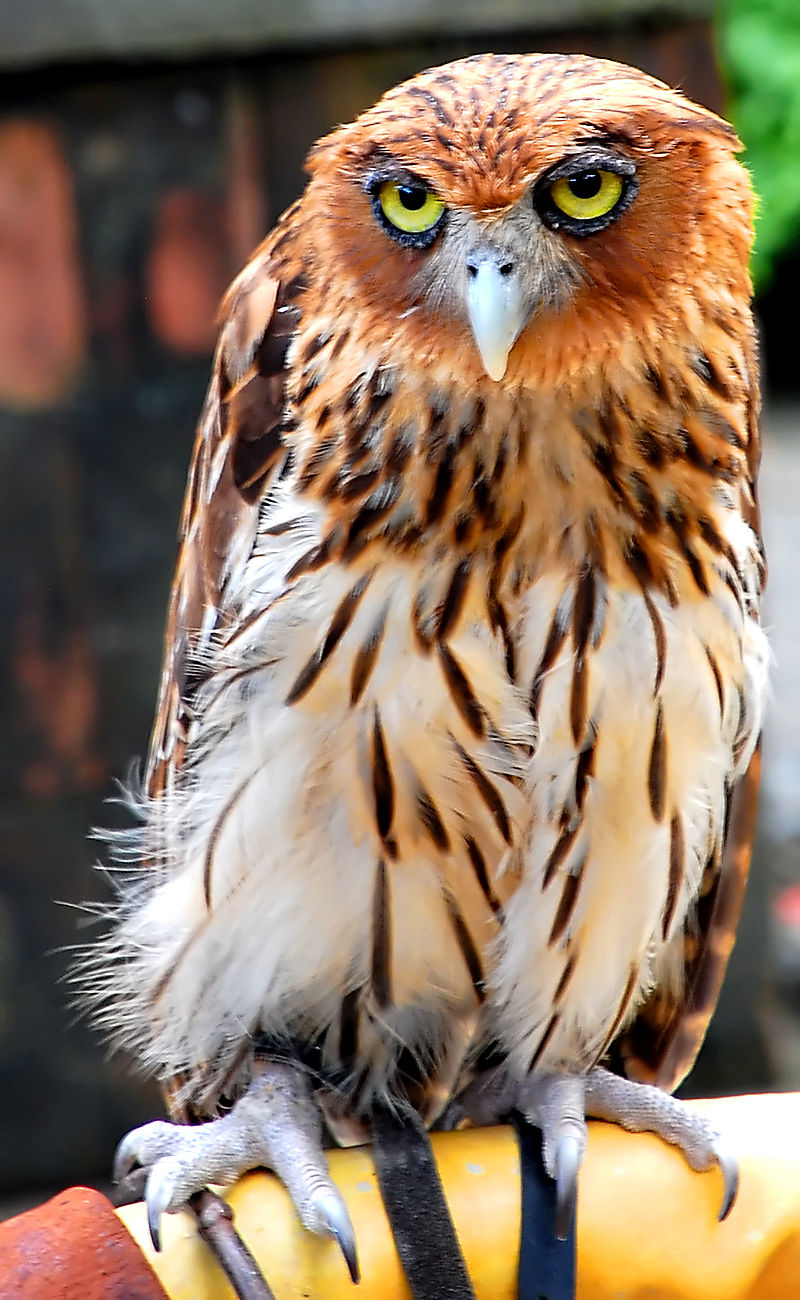
The Philippine eagle-owl is a vulnerable species of owl that is native to the Philippines. This bird can be found in lowland forests across several different islands.
Its diet consists mainly of rodents and amphibians. Unfortunately, the Philippine eagle-owl is facing threats due to its dependence on large forests, which are being destroyed at an alarming rate.Scientific classification:
| Kingdom | Animalia |
| Phylum | Chordata |
| Class | Aves |
| Order | Strigiformes |
| Family | Strigidae |
| Genus | Ketupa |
| Species | K. philippensis |
49. Blue-Crowned Racket-Tail
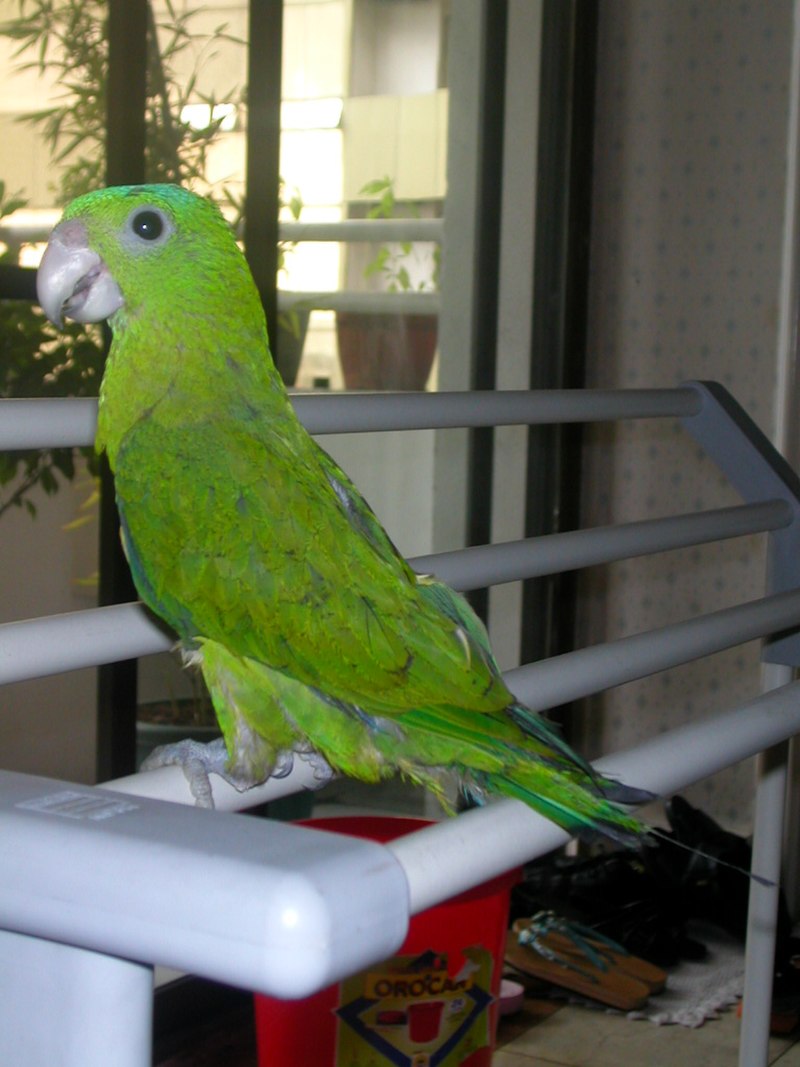
The Blue-crowned racket-tail is a species of parrot that can be found in several Philippine islands, except in Palawan and Panay.
It has a predominantly green body, with a blue crown and undertail, white beak, and dark underwings with green coverts.
This bird has a length of 27 cm. The Blue-crowned racket-tail thrives in humid environments. It has three subspecies. The Blue-headed racket-tail used to be a part of this species.Scientific classification:
| Kingdom | Animalia |
| Phylum | Chordata |
| Class | Aves |
| Order | Psittaciformes |
| Family | Psittaculidae |
| Genus | Prioniturus |
| Species | P. discurus |
50. Mindanao Bleeding-Heart
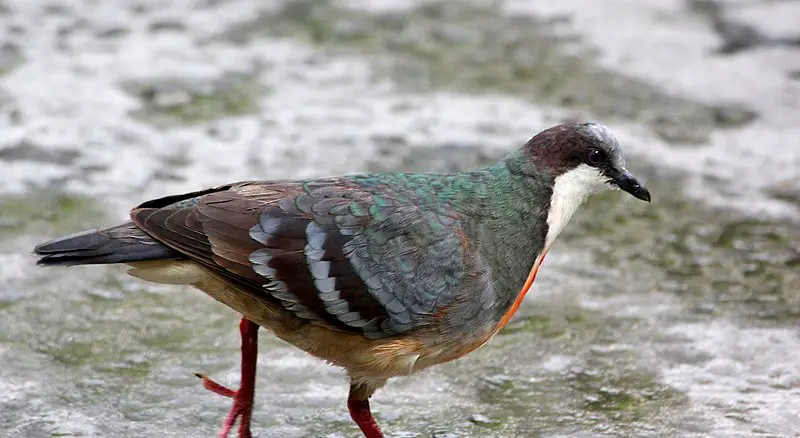
The Mindanao bleeding-heart bird is a pigeon species endemic to various Philippine islands, including Mindanao, Basilan, Samar, Leyte, and Bohol. Its distinguishing feature is a red blotch on its breast, which earned it its name.
This bird belongs to the pigeon family and is also known as Bartlett’s bleeding heart dove and the hair-breasted bleeding heart.
The generic name of the species reflects a fusion. The bird’s habitat and behavioral patterns are yet to be explored in greater detail.
The population of Mindanao bleeding-heart bird is threatened due to habitat loss and hunting. These birds are found in lowland forests, with most sightings occurring in primary and secondary forests.
There’s much to learn and discover about this species amidst the challenges they face in the wild.
Efforts are being made to protect and conserve their habitat and ensure their survival into the future.Scientific classification:
| Kingdom | Animalia |
| Phylum | Chordata |
| Class | Aves |
| Order | Columbiformes |
| Family | Columbidae |
| Genus | Gallicolumba |
| Species | G. crinigera |
Also Featured In: Samar Island Birds You Should Know,
51. McGregor’s Cuckooshrike
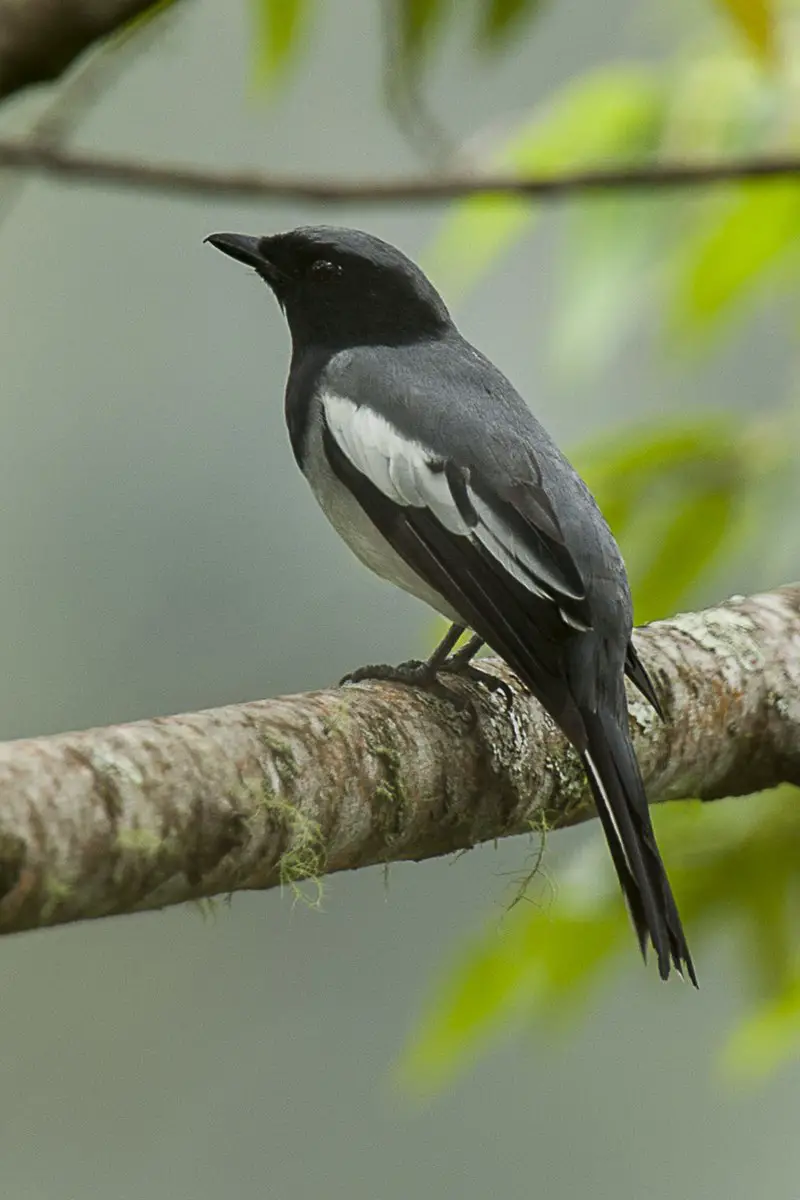
McGregor’s cuckooshrike, also known as the sharp-tailed cuckooshrike, is a unique bird species belonging to the Campephagidae family. This bird is exclusively found in the Mindanao island of the Philippines.
Initially, the species was categorized under the genus Coracina, but a 2010 molecular phylogenetic study deemed the genus non-monophyletic.
Consequently, a reorganization was necessary to create monophyletic genera, resulting in the introduction of Malindangia mcgregori.
McGregor’s cuckooshrike has distinct physical features such as a sharp tail, making it easy to differentiate from other bird species.Scientific classification:
| Kingdom | Animalia |
| Phylum | Chordata |
| Class | Aves |
| Order | Passeriformes |
| Family | Campephagidae |
| Genus | Malindangia Mearns, 1907 |
| Species | M. mcgregori |